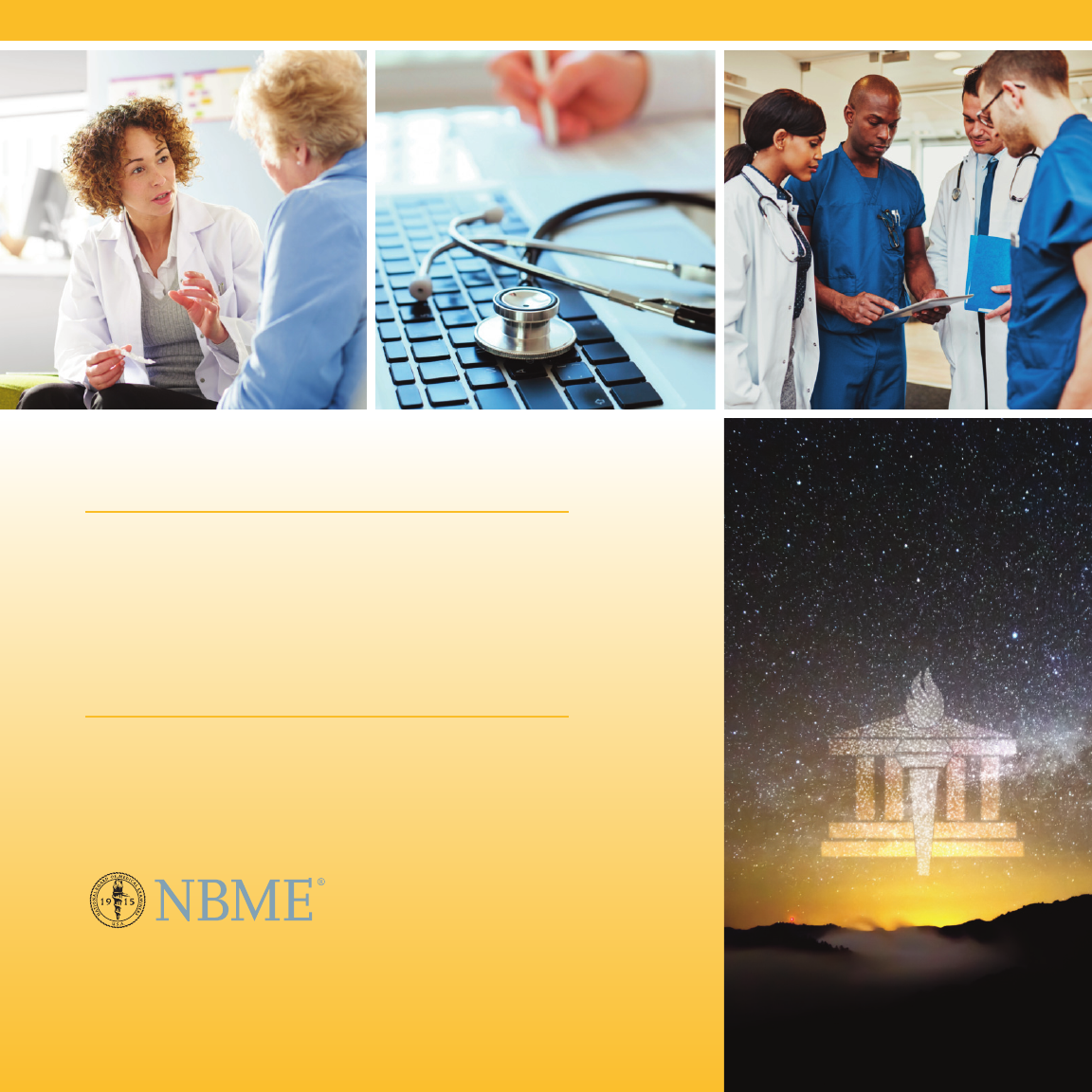
Constructing Written Test
Questions for the Basic
and Clinical Sciences
National Board of Medical Examiners
3750 Market Street
Philadelphia, PA 19104
Printed copies are not mailed, supplied, distributed or otherwise made available directly from the National Board
of Medical Examiners (NBME), except in conjunction with an NBME-sponsored activity (e.g., item writing work-
shop, meeting or seminar, promotional or otherwise). Additional copies can be obtained by downloading the manual
from the NBME U website. Permission to copy and distribute this document is granted by the NBME provided that:
(1) the copyright and permission notices appear on all reproductions; (2) use of the document is for noncommercial,
educational, and scientic purposes only; and (3) the document is not modied in any way. Any rights not expressly
granted herein are reserved by the NBME.
Copyright © 1996, 1998 National Board of Medical Examiners® (NBME®).
Copyright © 2001, 2002 National Board of Medical Examiners® (NBME®).
Copyright © 2016 National Board of Medical Examiners® (NBME®).
All rights reserved. Printed in the United States of America.

Constructing Written Test Questions
For the Basic and Clinical Sciences
Edited by
Miguel A. Paniagua, MD
Medical Advisor
Professional Services, Test Development Services
National Board of Medical Examiners
Kimberly A. Swygert, PhD
Director, Research and Development
Professional Services, Test Development Services
National Board of Medical Examiners
NATIONAL BOARD OF MEDICAL EXAMINERS
3750 MARKET STREET
PHILADELPHIA, PA 19104
Contributors from the National Board of Medical Examiners
Professional Services, Test Development Services
1
Melissa S. Billings
Director, Test Materials Development
Kristine DeRuchie
Director, Test Materials Development
Steven A. Haist, MD, MS
Vice President
Kieran Hussie
Manager, Multimedia Services and Applications
Jacquelyn Merrell
Managing Editor
Miguel A. Paniagua, MD
Medical Advisor
Kimberly A. Swygert, PhD
Director, Research and Development
Julie Tyson
Senior Editor
1
Contributing authors for the previous edition of this book also included Susan M. Case, PhD (NBME sta at the time of publication) and
David B. Swanson, PhD (NBME sta at the time of publication).

Section 1: Issues Related to Format and Structure of Test Items .............................................. 1
Chapter 1: Introduction ................................................................................................................................................... 3
Assessment: An Important Component of Instruction ....................................................................................................3
Issues of Content Sampling...................................................................................................................................................3
Issues of Psychometric Performance ...................................................................................................................................4
Purposes of Testing ................................................................................................................................................................4
What Material Should Be Tested? ........................................................................................................................................4
Chapter 2: Multiple-Choice Item Formats.......................................................................................................................5
True-False vs. One-Best-Answer Items...............................................................................................................................5
e True-False Family ...........................................................................................................................................................6
General Rules for True-False Items......................................................................................................................................7
Recommendations for Using True-False Items ..................................................................................................................7
e One-Best-Answer Family ..............................................................................................................................................8
General Rules for One-Best-Answer Items.......................................................................................................................10
Recommendations for Using One-Best-Answer Items...................................................................................................10
Chapter 3: Technical Item Flaws.....................................................................................................................................11
Flaws Related to Irrelevant Diculty ................................................................................................................................11
Flaws Related to Testwiseness.............................................................................................................................................15
Summary of Technical Item Flaws.....................................................................................................................................19
Chapter 4: Item Analysis and Interpretation of Results................................................................................................21
Analysis of Item Diculty ..................................................................................................................................................21
Analysis of Item Discrimination ........................................................................................................................................22
Analysis of Item Options.....................................................................................................................................................22
Comparative Analysis of Test-taker Groups.....................................................................................................................23
Example Items and Analysis...............................................................................................................................................24
Table of Contents

Section 2: Writing One-Best-Answer Items for the Foundational (Basic) and Clinical Sciences .... 27
Chapter 5: Basic Rules for Writing One-Best-Answer Items........................................................................................29
Chapter 6: Testing Application of Foundational (Basic) and Clinical Knowledge .....................................................33
Choosing the Topics to Test................................................................................................................................................33
Writing Clinical Vignettes...................................................................................................................................................33
Guidelines for Clinical Vignette Content..........................................................................................................................36
Writing Item Lead-ins .........................................................................................................................................................37
Item Example With and Without Vignette.......................................................................................................................37
Additional Points on Vignettes...........................................................................................................................................39
Structuring Items to Fit Task Competencies ....................................................................................................................40
Writing Items on Dicult Topics.......................................................................................................................................46
Chapter 7: Using Media as Part of Clinical Vignettes ...................................................................................................49
Types of Media......................................................................................................................................................................50
Selecting Media ....................................................................................................................................................................53
Content Areas Conducive to the Use of Media................................................................................................................55
Acquiring and Creating Media...........................................................................................................................................58
Tips for Creating Videos .....................................................................................................................................................61
Resources and Additional Reading on Item and Test Development ...................................... 63
Appendix A: NBME Retired Item Formats .............................................................................. 67
Appendix B: Sample Lead-ins Based on Provider Task Competencies .................................. 77
Medical Knowledge..............................................................................................................................................................79
Patient Care: Diagnosis .......................................................................................................................................................79
Patient Care: Management..................................................................................................................................................83
Communication and Interpersonal Skills.........................................................................................................................88
Professionalism and Legal/Ethical Issues..........................................................................................................................88
Systems-based Practice and Patient Safety .......................................................................................................................91
Practice-based Learning......................................................................................................................................................92

In 2015, during the celebration of the centennial of the NBME, we decided it was time to revisit and revise the text
aectionately known the world over as “the Red Book.” e purpose of this manual is, as it has always been, to help
faculty members across the health professions improve the quality of the multiple-choice items they write for their
examinations, and to help them better understand the nature of item development, item analysis, and some basics of
psychometrics and measurement. is manual provides a general overview of topics such as item and vignette writ-
ing for the foundational and clinical sciences (concentrating on the recommended item type of one-best-answer),
technical item aws, item analysis, and other areas that should provide useful guidance to the health sciences test de-
veloper. We anticipate that the primary users of this manual will be faculty members who are teaching health sciences
students in basic science courses and clinical training. e examples and templates focus on undergraduate health
sciences education, though the general approach to item writing should be useful for assessing test-takers at other
levels and across various healthcare professions.
is manual reects lessons that the NBME Test Development Services unit has learned in developing items and
examinations over the past 30 years. During this time, NBME sta members have reviewed countless multiple-choice
items and have worked with hundreds of test material development, item writing, and item review committees for
USMLE Step exams, NBME exams, and specialty board exams. In addition, our sta members have been fortunate to
have had the opportunity to conduct item writing workshops for thousands of item writers, including faculty mem-
bers at hundreds of national and international health science schools who were interested in developing items for
their own examinations. We can personally attest that each committee and workshop attendee has helped us
examine our methods, rethink our arguments, and better frame our thoughts regarding how to write high-quality test
items. We hope the revised version of this manual continues to be a source of wisdom and encouragement for item
writers throughout the health professions world. Finally, we are indebted to our editorial predecessors, on whose
broad shoulders we have stood in enhancing this text.
Miguel A. Paniagua, MD
Kimberly A. Swygert, PhD
Test Development Services
National Board of Medical Examiners
December 2016
Preface to the Fourth Edition
This fourth edition is dedicated to Drs. Donald Melnick and Gerry Dillon
for their tireless efforts in promoting the NBME values
which this book and its predecessors embody.

Section 1:
Issues Related to Format
and Structure of Test Items

3
ASSESSMENT: AN IMPORTANT COMPONENT OF INSTRUCTION
Assessment, also known as testing, is a critical component of instruction. When properly used, it can aid in accom-
plishing key curricular goals. A primary purpose of testing is to communicate what you, as the instructor and item
writer, view as important. Tests are a powerful motivator, and your test-takers or students will learn the educational
concepts they believe you value. Assessment also helps to ll instructional gaps by encouraging students to read
broadly on their own and participate more as educational opportunities are available. is outcome of testing is espe-
cially important in clinical learning environments, where the curriculum may vary from student to student, depend-
ing on factors such as the setting and the ow of patients. is outcome may also be important in some basic science
settings, where the educational experiences may vary from student to student. As students progress toward mastery
or even excellence, they are aided by ongoing feedback from their instructors, and tests are oen an important com-
ponent of that feedback and useful in activating further learning.
Because tests have such a powerful inuence on student learning, it is important to develop tests that will properly
align with educational goals. is manual focuses on the process of writing high-quality, multiple-choice questions
(MCQs), aka items, that can be used to assess a wide variety of clinical knowledge and skills within the framework of
the basic and clinical sciences.
Two issues are of particular concern when developing and constructing quality MCQ-based exams; these are issues of
content sampling and psychometric performance.
ISSUES OF CONTENT SAMPLING
e purpose of any assessment is to permit inferences to be drawn concerning the skills of test takers or examinees.
Inferences are dened here as decisions, judgments, or conclusions that extend beyond the particular set of items in-
cluded in the exam into the larger domain from which the items were sampled. Performance on the test provides a
basis for estimating achievement in the broader domain that is actually of interest, and this broader domain should
be made explicit with statements about the inferences to be made from the test.
e rst decision to be made involves the content to be sampled on the test; content decisions will drive the number
and topic areas of the MCQs to be developed. e amount of attention given to evaluating a content area should reect
its relative importance, and it is oen impractical to cover all testing topics in equal lengths. Tests are point-in-time
Chapter 1: Introduction

CHAPTER 1: INTRODUCTION4
measurements that take a specic and limited amount of time; if one content area contains many items, there is less
testing time for other content areas. e nature of the test determines the extent to which the estimate of achievement
is reproducible (aka reliable or generalizable) and accurate (valid). If the test questions are not adequately representa-
tive of the broader domain of interest (e.g., a test of competence in general medical practice includes only cardiovascu-
lar-related content), the test results may be biased and may not provide a good basis for estimating achievement in the
domain of interest. If the overall test length is too short, the scores may not be suciently precise or reliable to ensure
they are a good representation of true prociency. In order to generate a reproducible score, the item writer needs to
sample content broadly (i.e., typically 100 or more MCQs or short-answer items for text-based exams).
ISSUES OF PSYCHOMETRIC PERFORMANCE
e process of evaluating the psychometric characteristics of an assessment and weighting their relative importance
is determined by the purpose of the test and the decisions that will be made based on the results. For tests with higher
stakes, such as those used for promotion or graduation decisions, those used for course grades, or those used in isola-
tion for decisions, the scores must be reasonably reproducible (as demonstrated by high reliability) and evidence
should be presented to demonstrate the accuracy of the test (e.g., showing how content outlines for the test match the
inferences to be made). For tests with lower stakes, such as those on which the score is but one element of the deci-
sion-making process, the amount of required psychometric evidence is less, but attention should be paid to evidence
of test reliability and validity of score use nonetheless (see Figure 1 in Chapter 6 for more information).
PURPOSES OF TESTING
• Communicate to students material that is important
• Motivate students to study
• Identify areas of deciency, in need of remediation, or further learning
• Determine nal grades or make promotion decisions
• Identify areas where instruction can be improved
WHAT MATERIAL SHOULD BE TESTED?
• Exam content should align with course or clinical experience objectives
• Important topics should be weighted more heavily than less important topics
• e testing time devoted to each topic should reect the relative importance of the topic
• e sample of items should be representative of the instructional goals

5
One of the most crucial aspects of a multiple-choice test item or question (MCQ) is its type or structure. Dierent
item types can be used for dierent topic areas, and each item type carries with it advantages and disadvantages. One
critical aspect to keep in mind when choosing an item type is not only the ease of writing that item type for a given
content area, but also the potential aws that might benet the savvy test-taker or introduce irrelevant diculty. is
chapter covers the basics of several multiple-choice item formats and introduces some potential aws that are com-
mon to specic formats, while Chapter 3 will discuss specic item aws in more detail.
TRUEFALSE VS. ONEBESTANSWER ITEMS
e universe of multiple-choice items can be divided into two families: those that require test-takers to indicate all re-
sponses that are appropriate (true-false), and those that require test-takers to indicate a single, most accurate re-
sponse (one-best-answer). e NBME has used multiple item formats within each family in the past, listed below by
designating letter.
True-false item formats that require test-takers select some set of options that are true:
• C-type (A/B/Both/Neither response items)
• K-type (complex true-false items)
• X-type (simple true-false items)
One-best-answer item formats that require test-takers select the single best response:
• A-type (4 or more options, single items or sets)
• B-type (4- or 5-option matching items, in sets of 2 to 5 items)
• F-type (items grouped into sets around specic content, where test-takers cannot return to previously
seen items in the set)
• G-type (items grouped into sets around specic content, where test-takers can return to previously
seen items in the set)
• R-type (extended-matching items, in sets of 5 to 20 items)
e letters used to label the item formats hold no intrinsic meaning; letters were assigned more or less sequentially to
new item formats as they were developed. For an extended list of item types formerly used by the NBME, ordered by
their designated letters, see Appendix A: NBME Retired Item Formats.
Chapter 2: Multiple-Choice Item Formats
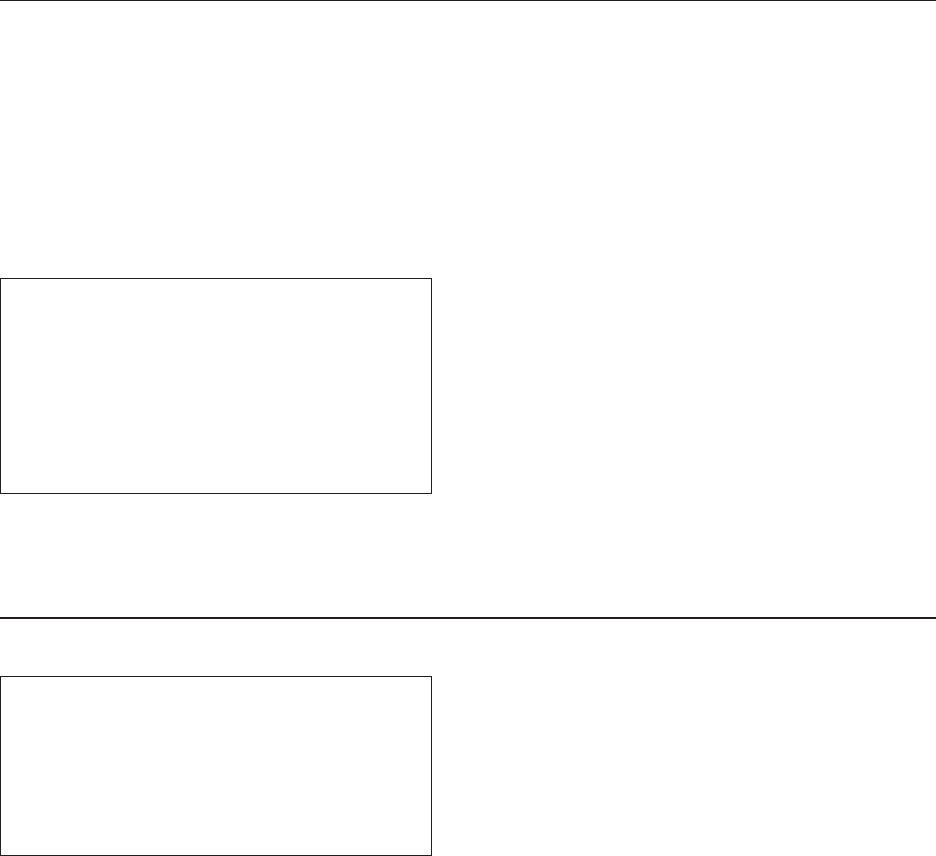
CHAPTER 2: MULTIPLE-CHOICE ITEM FORMATS6
THE TRUEFALSE FAMILY
True-false items require test-takers to select all the options that are “true,” which could be anywhere from one to all of
the listed options. In solving these items, the test-taker must decide where to make the cuto and determine to what
extent a response must be “true” in order to be keyed as “true.” While this task requires additional judgment beyond
what is required to select the true answer(s), that additional judgment may be unrelated to clinical expertise or
knowledge. Too oen, test-takers have to guess what the item writer had in mind because the options are not either
completely true or completely false.
Which of the following are X-linked recessive condi-
tions?
1. Cystic fibrosis
2. Duchenne muscular dystrophy
3. Hemophilia A (classic hemophilia)
4. Tay-Sachs disease
e options can be diagrammed as follows.
1 2
4 3
Totally Incorrect Totally Correct
True statements about cystic fibrosis (CF) include:
1. CF is an autosomal recessive disease
2. Children with CF usually die in their teens
3. Males with CF are sterile
4. The incidence of CF is 1:2000
is item demonstrates a commonly seen aw for true-false
items that oen occurs when options are not homogenous
and vaguely worded. Options 2, 3 and 4 cannot be judged as
absolutely true or false, because a group of content experts
would not necessarily agree on the answers. For example, for
option 4, experts would demand more information to deter-
mine incidence: Is this in the United States? Is this among all
ethnic groups? Similar issues arise with options 2 and 3,
whereas option 1 is clear. Revision of this item would most
likely include editing options 2, 3, and 4, to be statements of
fact like option 1, and revising the question itself to be closed.
is item is an example of a reasonably acceptable true-
false item from a structural perspective. Note that the
stem is clear and the options are absolutely true or false
with no ambiguity. Following tradition, for true-false
items, the options are numbered. Options should be ho-
mogenous (all are conditions), clearly worded, and of sim-
ilar length, and the question should be closed and focused.

CHAPTER 2: MULTIPLE-CHOICE ITEM FORMATS 7
GENERAL RULES FOR TRUEFALSE ITEMS
Because test-takers are required to select all the options that are “true,” true-false items must satisfy the following rules:
• Item and option text must be clear and unambiguous. Avoid imprecise phrases such as “is associated with”
or “is useful for” or “is important”; words that provide cueing such as “may” or “could be”; and vague terms
such as “usually” or “frequently.”
• e lead-in should be closed and focused.
• Options must be absolutely true or false; no shades of gray are permissible.
• Options should be homogenous so that they can be judged as entirely true or entirely false on a
single dimension.
RECOMMENDATIONS FOR USING TRUEFALSE ITEMS
We recommend avoiding true-false questions if possible. Although many item writers believe true-false items are eas-
ier to write than one-best-answer items, this type can oen be more problematic. e writer may have something
particular in mind when writing the item, but careful review subsequently reveals subtle diculties that were not ap-
parent to the item author. Oen the distinction between “true” and “false” is not clear, and it is not uncommon for
subsequent reviewers to alter the answer key. As a result, reviewers tend to rewrite or discard true-false items far
more frequently than items written in other formats. Some ambiguities can be easily claried, but others cannot.
ere is a nal reason to avoid true-false questions, and that is, in order to avoid ambiguity with this item type, item
In children, ventricular septal defects are
associated with:
1. cyanosis
2. pulmonary hypertension
3. systolic murmur
4. tetralogy of Fallot
e problems with this true-false item are more subtle.
e diculty is that the test-taker has to make assump-
tions about the severity of the disease, the age of the pa-
tient, and whether or not the disease has been treated. is
is due in part to the vagueness in the question itself (“asso-
ciated with”). Dierent assumptions lead to dierent an-
swers, even among experts. Revising this question would
require adding additional text, perhaps a lot of it, in order
to allow the test-taker to judge the options as wholly true
or wholly false.

CHAPTER 2: MULTIPLE-CHOICE ITEM FORMATS8
writers oen lean toward assessing recall of an isolated fact. is is something we recommend item writers avoid.
Application of knowledge, integration, synthesis, and judgment questions can be better assessed by one-best-answer
questions. As a result, the NBME has completely stopped using true-false formats on its examinations.
THE ONEBESTANSWER FAMILY
In contrast to true-false questions, one-best-answer questions make explicit that only one option is to be selected.
ese items are the most widely used multiple-choice item format. ey consist of a stem (e.g., a clinical case presen-
tation) and a lead-in question, followed by a series of choices, with one correct answer and anywhere from three to
ve distractors. is question describes a situation (in this instance, a patient scenario) and asks the test-taker to indi-
cate the most likely cause of the problem.
Stem:
A 32-year-old man has a 4-day history of progressive weakness in his extremities. He has been healthy except for an
upper respiratory tract infection 10 days ago. His temperature is 37.8°C (100.0°F), pulse is 94/min, respirations are
42/min and shallow, and blood pressure is 130/80 mm Hg. He has symmetric weakness of both sides of the face and
the proximal and distal muscles of the extremities. Sensation is intact. No deep tendon reflexes can be elicited. Babin-
ski sign is present.
Lead-in:
Which of the following is the most likely diagnosis?
A. Acute disseminated encephalomyelitis
B. Guillain-Barré syndrome*
C. Myasthenia gravis
D. Poliomyelitis
E. Polymyositis
Note that the incorrect options are not wholly wrong. e options can be diagrammed as follows:
DCA E B
Least Likely Diagnosis Most Likely Diagnosis
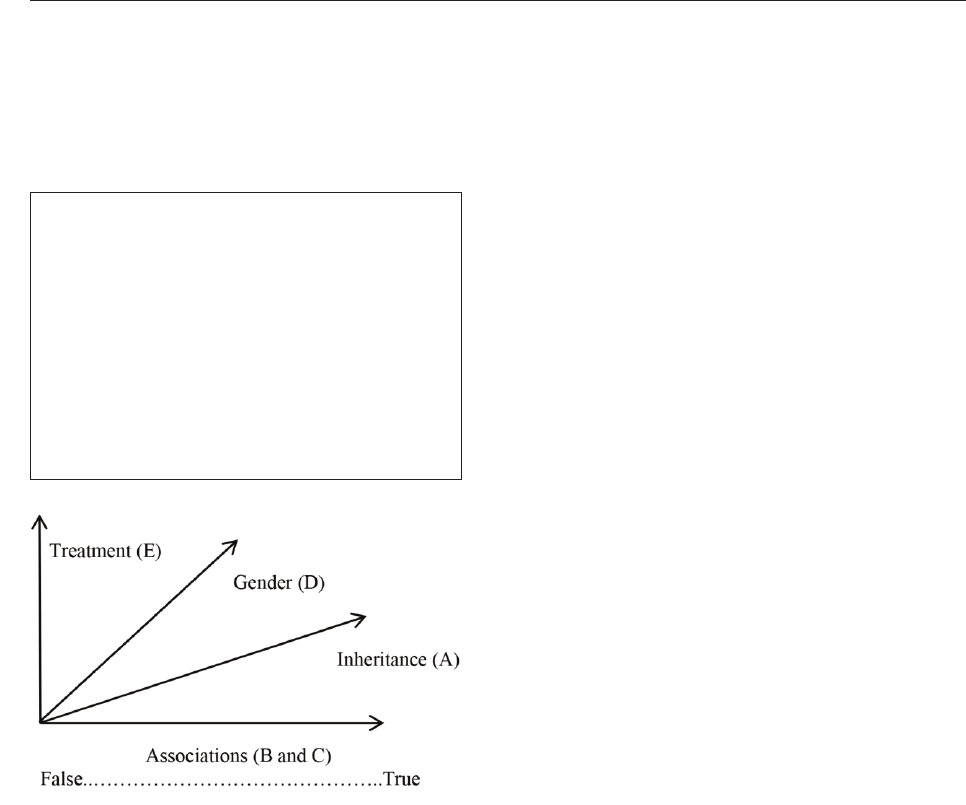
CHAPTER 2: MULTIPLE-CHOICE ITEM FORMATS 9
Even though the incorrect answers are not completely wrong, they are less correct than the “keyed answer” indicated
by the asterisk in the option set. e test-taker is instructed to select the “most likely diagnosis.” Experts would all
agree that the most likely diagnosis is B; they would also agree that the other diagnoses are somewhat likely, but less
likely than B. As long as the options can be laid out on a single continuum, in this case from “Least Likely Diagnosis”
to “Most Likely Diagnosis,” distractors in one-best-answer questions do not have to be totally wrong.
is leads us to another important guideline for writing good one-best-answer items—the “cover-the-options” rule.
If a lead-in is properly focused, a test-taker should be able to read the stem and lead-in, cover the options, and guess
what the right answer is without seeing the option set. For example, in this next item, aer reading the lead-in, the
test-taker should be able to answer the question (ibuprofen) without seeing the options. When writing items, cover-
ing the options and attempting to answer the item is a good way to check whether this rule has been followed.
Which of the following is true about pseudogout?
A. It is clearly hereditary in most cases
B. It is seldom associated with acute pain
in a joint
C. It may be associated with a finding of
chondrocalcinosis
D. It occurs frequently in women
E. It responds well to treatment with allopurinol
Some recommendations for writing one-best-answer types
are similar to those for true-false items. Use of a focused
lead-in, homogenous options that fall on a single dimen-
sion, and avoidance of vague terms are all recommended.
is one-best-answer example is a awed item that can
occur when options are not listed on a single dimension.
Aer reading the stem, the test-taker has only the vaguest
idea what the question is about. In an attempt to determine
the “best” answer, the test-takers have to decide whether “it
occurs frequently in women” is more or less true than “it is
seldom associated with acute pain in a joint.”
e diagram of these options might look like the gure to
the le. e options are heterogeneous and deal with mis-
cellaneous facts; they cannot be rank-ordered from least to
most true along a single dimension. Although this ques-
tion appears to assess knowledge of several dierent
points, its inherent aws preclude this. e question by it-
self is not clear; the item cannot be answered without
looking at the options.

CHAPTER 2: MULTIPLE-CHOICE ITEM FORMATS10
A 58-year-old man comes to the office because of pain in the right knee for the past 3 days. He has a history of type 2
diabetes mellitus, hypertension, and hyperlipidemia controlled with an oral hypoglycemic drug and an ACE inhibitor.
There is no family history of similar disorders. On physical examination, the knee is swollen, passive motion produces
pain, and ballottement discloses an effusion. Synovial fluid is cloudy and contains positive birefringent crystals and no
bacteria. X-ray shows chondrocalcinosis. Which of the following is the most appropriate pharmacotherapy?
A. Allopurinol
B. Betamethasone
C. Ibuprofen*
D. Infliximab
E. Levofloxacin
GENERAL RULES FOR ONEBESTANSWER ITEMS
Because test-takers are required to select the single best answer, one-best-answer items must satisfy the following
rules (for more detail, see Chapter 6):
• Item and option text must be clear and unambiguous. Avoid imprecise phrases such as “is associated with”
or “is useful for” or “is important”; words that provide cueing such as “may” or “could be”; and vague terms
such as “usually” or “frequently.”
• e lead-in should be closed and focused, and ideally worded in such a way that the test-taker can cover
the options and guess what the correct answer is. is is known as the “cover-the-options” rule.
• All options should be homogeneous so that they can be judged as entirely true or entirely false on a single
dimension.
• Incorrect options can be partially or wholly incorrect.
RECOMMENDATIONS FOR USING ONEBESTANSWER ITEMS
We recommend using one-best-answer questions whenever possible. is format helps prevent confusion on the part
of the test-taker from having to guess the author’s intent. In addition, this format can also be easier and more e-
cient to write because wrong options do not have to be entirely incorrect, and dierent lead-ins can be paired with
the same stems (a patient scenario stem can include items with lead-ins about diagnosis and management) to create
item sets. e NBME currently uses only one-best-answer format items on exams.

11
e purpose of this chapter is to describe two kinds of technical item aws. e rst kind is the aw that articially
increases the diculty of the item, which can confuse all test-takers. ese aws related to irrelevant diculty make
the item challenging for reasons unrelated to the trait that is the focus of assessment and can add construct-irrelevant
variance to the nal test score. e second kind cues the more savvy and condent test-takers (aka, the “testwise”)
and aids them in guessing the right answer. ese aws related to “testwiseness” make it easier for some students to
answer the item correctly based on their test-taking skills alone, without necessarily knowing the content. e item
writer’s goal is to develop and structure items so as to eliminate both types of aws as much as possible, in order to
create a test that assures a level playing eld for all students. A test-taker’s probability of answering an item correctly
should be determined by his or her amount of expertise on the topic being assessed; ideally, that probability will not
decrease due to a suboptimally written item, and will not increase due to test-taking strategies.
FLAWS RELATED TO IRRELEVANT DIFFICULTY
Options are overly long or complicated
e item below has several aws. e stem contains extraneous information, and in fact, the stem is not needed to
answer the question. More importantly, the options themselves are overly long and complicated. e number of
words in each option increases the reading load, which can shi the construct that is being measured from content
knowledge to reading speed. Please note that this aw relates only to options. ere are many well-constructed test
questions that include a long stem, and decisions about stem length should be made in accordance with the testing
point of the item. If the purpose of the item is to assess whether or not the student can interpret and synthesize infor-
mation to determine, for example, the most likely diagnosis for a patient, then it is appropriate for the stem to include
a fairly complete description of the situation.
Peer review committees in HMOs may move to take action against a physician’s credentials to care for participants of
the HMO. There is an associated requirement to assure that the physician receives due process in the course of these
activities. Due process must include which of the following?
A. Notice, an impartial forum, council, and a chance to hear and confront evidence
B. Proper notice, a tribunal empowered to make the decision, a chance to confront witnesses,
and a chance to present evidence in defense
C. Reasonable and timely notice, an impartial panel empowered to make a decision, a chance to hear
evidence and to confront witnesses, and the ability to present evidence in defense
Chapter 3: Technical Item Flaws
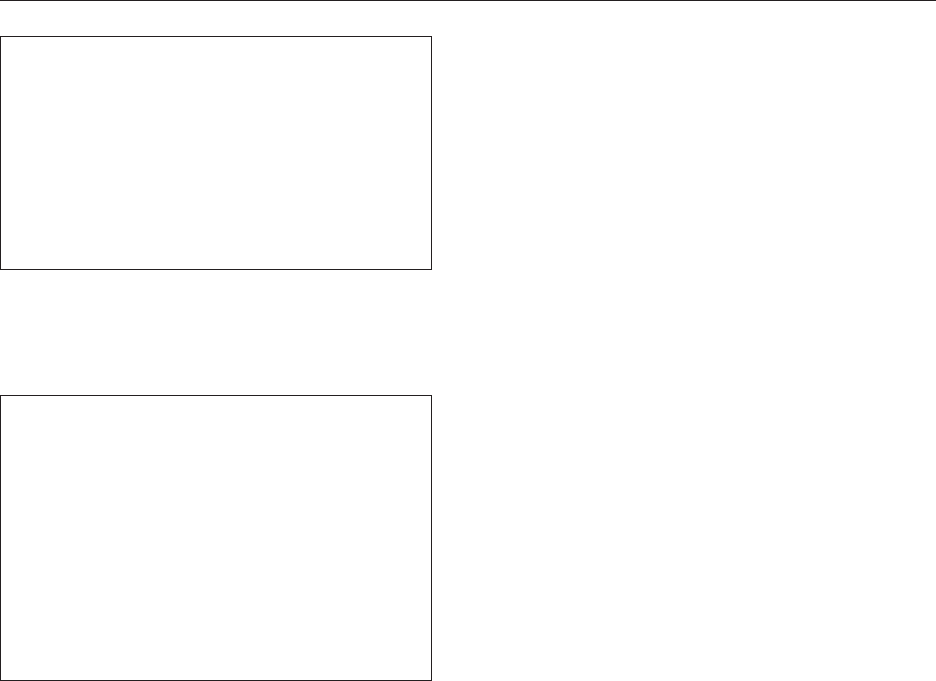
CHAPTER 3: TECHNICAL ITEM FLAWS12
After a second episode of infection, which of the
following is the likelihood that a woman is infertile?
A. Less than 20%
B. 20 to 30%
C. Greater than 50%
D. 75%
E. 90%
Numeric data are not presented consistently
When numeric options are used, the options should be
listed in numeric order and in a single format (i.e., as
terms or ranges). Confusion can occur when formats are
mixed or when options are listed in an illogical order. In
this example, options A, B, and C are expressed as ranges,
whereas options D and E are specic percentages. All op-
tions should be expressed as ranges or as specic percent-
ages; mixing them is ill-advised. In addition, the range for
option C includes options D and E, which almost certainly
rules out options D and E as correct answers for the test-
wise examinee.
Severe obesity in early adolescence:
A. has a 75% chance of clearing
spontaneously
B. often is related to endocrine disorders
C. shows a poor prognosis
D. usually responds dramatically to dietary
regimens
E. usually responds to pharmacotherapy
and intensive psychotherapy
Frequency terms that are vague and open to interpreta-
tion are used in the options
Vague frequency terms in the options (such as “oen” or
“usually”) are not consistently dened or interpreted by
the readers, and sometimes not even by experts. is can
lead to multiple correct answers or a set of options that
cannot be rank ordered in terms of correctness.

CHAPTER 3: TECHNICAL ITEM FLAWS 13
“None of the above” is used as an option
e phrase “None of the above” is problematic in items where judgment is involved and the options are not absolutely
true or false. If the correct response is intended to be one of the other listed options, knowledgeable students are
faced with a dilemma because they have to decide between the option that the item writer has intended as correct and
an option that encompasses everything not listed in the option set. Test-takers can oen intuit an option that is more
correct than the item writer intended to be correct, which would lead them to use the more expansive option. Use of
“none of the above” essentially turns the item into a true-false item; each option has to be evaluated as more or less
true than the universe of unlisted options. It is oen possible to x such items by replacing “none of the above” with
an option that is more specic. In this item, which asks a test-taker to specify the most appropriate pharmacotherapy,
if the correct answer is to administer no pharmacotherapy, option E, “None of the above” should be replaced by “No
management is indicated at this time,” to eliminate any ambiguity while still requiring the test-taker to commit to a
management decision.
A 39-year-old man is brought to the hospital by his brother because he has become forgetful and confused and wan-
ders at night because he cannot sleep. He has been drinking heavily and eating very little and has been slightly nause-
ated and tremulous for 4 weeks. On admission, 5% dextrose in water is initiated IV. Two hours later, the patient has
ophthalmoplegia and is oriented to person only. Which of the following is the most appropriate next step in man-
agement?
A. Administration of dabigatran
B. Administration of diazepam
C. Administration of large doses of vitamin B1*
D. Administration of large doses of vitamin C
E. None of the above
Options are not homogeneous or parallel
e next item illustrates a common aw where the options are not only too long but the structure of each option is
dierent, both of which add to the reading time. Generally, this aw can be corrected by careful editing to ensure that
the options all have the same format and the same structure. In this particular item, the lead-in can be changed to
“Which of the following is the most likely reason no conclusion can be drawn from these results?” Each option can
then be edited to t a logical and parallel answer to the lead-in.

CHAPTER 3: TECHNICAL ITEM FLAWS14
In a vaccine trial, 200 two-year-old boys were given a vaccine against a certain disease and then monitored for 5 years
for occurrence of the disease. Of this group, 85% never contracted the disease. Which of the following statements
concerning these results is correct?
A. The number of cases (i.e., 30 cases over 5 years) is too small for statistically meaningful conclusions
B. Vaccine efficacy (%) is calculated as 85-15/100
C. No conclusions can be drawn because the trial involved only boys
D. No conclusion can be drawn since no follow-up was done with nonvaccinated children
Stems are unnecessarily complicated
is item, as written, requires that the student (a) understands the concepts of genetics that are represented and (b) is
able to rank order Roman numerals (the second of which is an irrelevant and unnecessarily dicult addition to the
goal of the item). is item should be rewritten with the karyotypes arranged in the options themselves, so that the
student who understands the order of risk of occurrence can more easily identify the correct answer.
Arrange the parents of the following children with Down syndrome in order of highest to lowest risk of recurrence.
Assume that the maternal age in all cases is 22 years and that a subsequent pregnancy occurs within 5 years. The
karyotypes of the daughters are:
I: 46, XX, -14, +T (14q21q) pat
II: 46, XX, -14, +T (14q21q) de novo
III: 46, XX, -14, +T (14q21q) mat
IV: 46, XX, -21, +T (14q21q) pat
V: 47, XX, -21, +T (21q21q) (parents not karyotyped)
A. III, IV, I, V, II
B. IV, III, V, I, II
C. III, I, IV, V, II
D. IV, III, I, V, II
E. III, IV, I, II, V

CHAPTER 3: TECHNICAL ITEM FLAWS 15
FLAWS RELATED TO TESTWISENESS
Presence of grammatical cues
is aw exists when an option does not follow grammatically from the stem or lead-in. In this example, testwise stu-
dents can eliminate A and C as possible correct answers because they do not follow grammatically or logically from
the lead-in. Testwise students then have to choose only between B, D, and E. is can happen when an item writer fo-
cuses more attention on writing the correct answer than on the distractors, leading to the potential for grammatical
errors. To avoid this aw, read each option immediately following the stem to ensure that the language is a good t.
Another way to avoid the aw is to always use closed lead-ins, which helps the item writer avoid this problem.
A 60-year-old man is brought to the emergency department by the police, who found him lying unconscious on the
sidewalk. After ascertaining that the airway is open, the first step in management should be intravenous adminis-
tration of:
A. CT scan of the head
B. diazepam
C. examination of cerebrospinal fluid
D. glucose with vitamin B1 (thiamine)*
E. phenytoin
Each of the following statements about cholesterol
is true EXCEPT:
1. Cholesterol contains numerous fatty acids
2. Cholesterol is not present in any foods of
plant origin
3. Cholesterol is required in many complex
bodily functions
4. Endogenous cholesterol is produced within
the body
Stems are negatively phrased
A negative phrasing in the stem asks the test-taker to nd
the most false or least accurate option, with the rest being
accurate, rather than to nd the most accurate option. If
most of the items on a test are positively phrased, the in-
clusion of a negatively phrased item stem carries the risk
that the student will miss the word “except,” even when it
is set in bold and/or capitalized.

CHAPTER 3: TECHNICAL ITEM FLAWS16
Administration of furosemide results in:
A. a decrease in urine potassium
B. an increase in urine potassium
C. improved glucose control in patients with
type 2 diabetes
D. no change in urine potassium
E. requires decreasing the dose with
renal failure
Presence of grouped or collectively exhaustive options
is aw exists when a savvy student can identify a subset
of options that cover all possible outcomes (are collectively
exhaustive) and rule out the options not in that subset. In
this item, options A, B, and D are exhaustive – urine
potassium can only increase, decrease, or not change –
and thus one of the three options must be the correct an-
swer. A less testwise student might spend time considering
C and E. Oen, item writers add options like C and E only
because they want to have a total of ve options, but it is
not an improvement of the item to add options that have
no merit. e item writer should be able to rank order
each option on the same dimension, and no subset of op-
tions should include all possible outcomes.
In patients with advanced dementia, Alzheimer
type, the memory defect:
A. can be treated adequately with
phosphatidylcholine (lecithin)
B. could be a sequela of early parkinsonism
C. is never seen in patients with neurofibrillary
tangles at autopsy
D. is never severe
E. possibly involves the cholinergic system
Use of absolute terms
In this item, options A, B, and E contain terms that are less
absolute than those in options C and D. e testwise stu-
dent will eliminate options C and D as possibilities, be-
cause they are less likely to be true than something stated
less absolutely, and so this item is awed with the inclu-
sion of those terms. is aw tends to arise when verbs are
included in the options rather than in the lead-in. Focus-
ing the stem, placing the verb in the stem, and shortening
the options are possible ways to correct this aw.
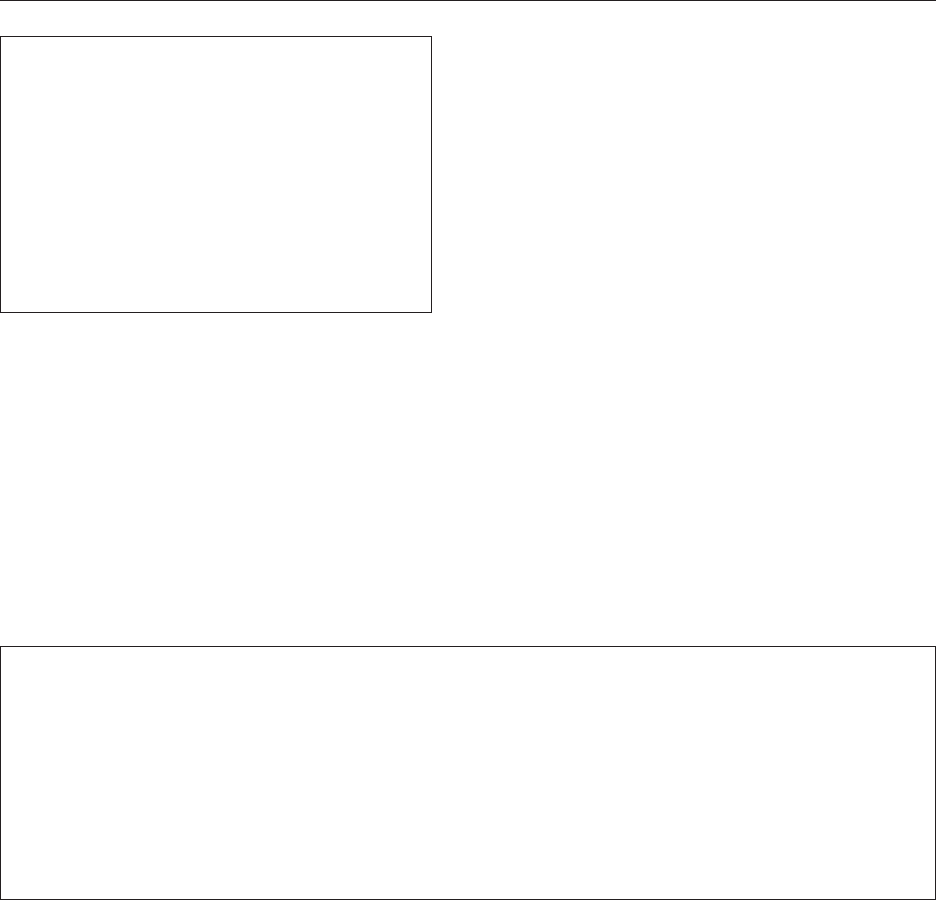
CHAPTER 3: TECHNICAL ITEM FLAWS 17
Presence of word repetition (“clang clues”)
is aw arises when language used in the lead-in is repeated in the options. Here, the word “unreal” in the stem can
clue test-takers to the fact that the correct answer, “derealization,” is the only option that also includes the word “real.”
e same aw can appear even if a word is repeated only in a metaphorical sense, such as when a stem mentions bone
pain and the correct answer begins with the prex “osteo-.” Item writers should scan the options and item stem to
check for this word or phrase repetition.
A 58-year-old man with a history of heavy alcohol use and previous psychiatric hospitalization is confused and
agitated. He speaks of experiencing the world as unreal. This symptom is called:
A. depersonalization
B. derailment
C. derealization*
D. focal memory deficit
E. signal anxiety
Secondary gain is:
A. a complication of a variety of illnesses and
tends to prolong many of them*
B. a frequent problem in obsessive-compulsive
disorder
C. never seen in organic brain damage
D. synonymous with malingering
e correct option is longer, more specic, or more
complete
In this item, the correct answer, option A, is longer than
the other options, and is the only “double” option. is
aw is another potential outcome when item writers pay
more attention to constructing the correct answer than the
distractors. One reason for this is that item writers likely
create the correct answer rst and then write the incorrect
distractors. Another potential reason is that because item
writers are oen teachers, they will construct long correct
answers that include additional instructional material,
parenthetical information, caveats, and so on. is aw
can be avoided by reviewing the entire item set for length
and removing language that is purely for instructional
purposes only.

CHAPTER 3: TECHNICAL ITEM FLAWS18
Local anesthetics are most effective in the:
A. anionic form, acting from inside the nerve
membrane
B. cationic form, acting from inside the nerve
membrane*
C. cationic form, acting from outside the nerve
membrane
D. uncharged form, acting from inside the
nerve membrane
E. uncharged form, acting from outside the
nerve membrane
Presence of convergence
is item aw might be less obvious than the others, but it
occurs frequently and is worth noting. e underlying
aw is that the correct answer is the option that has the
most in common with the other options, and thus the test-
wise student can converge on the right answer just by
counting the number of times certain terms appear. In this
example, the testwise student would eliminate “anionic
form” as unlikely because “anionic form” appears only
once; that student would also exclude “outside the nerve
membrane” because “outside” appears less frequently than
“inside.” e student would then have narrowed the op-
tions to B and D. Since three of the ve options involve a
charge, the testwise student would then select option B,
which is in fact the correct answer. is aw can also
occur without being directly reected in the language; for
example, if an item is asking which pharmacotherapy is
most eective, and three of the ve options are in one class
of drugs, the savvy student may rule out the other two as
less likely. is aw occurs when item writers start with
the correct answer and write the distractors as permuta-
tions of the correct answer. e correct answer will then
be more likely to have elements in common with the rest
of the options, and the incorrect answers are more likely to
be outliers. A useful check is to review all options and see
if words or terms are repeated across options.

CHAPTER 3: TECHNICAL ITEM FLAWS 19
SUMMARY OF TECHNICAL ITEM FLAWS
Flaws Related to Irrelevant Diculty
• Options are overly long or complicated
• Numeric data are not stated consistently
• Terms in the options or the stem are vague
• Language or structure of the options is not homogeneous
• Options are not in a logical order
• “None of the above” is used as an option
• Stems are unnecessarily complicated
• Stems contain negative phrasing
Flaws Related to Testwiseness
• Grammatical cues exist because one or more distractors don’t follow grammatically from the stem
• Options are cued by being paired or exhaustive, where some options can be eliminated because other
options cover all possible outcomes
• Absolute terms such as “always” or “never” are in some options
• e correct answer is longer, more specic, or more complete than the other options
• A word or phrase is included both in the stem and in the correct answer
• Convergence (the correct answer includes the most elements in common with the other options) is present

21
Item analysis can provide very useful information about the performance of items or questions for a given group of
test-takers. Item analysis includes a routine set of analyses that should be done before nal test scores are calculated
and before grades are provided to students. is chapter covers the most common types of item analyses used in test-
ing, as listed below, and provides some illustrative examples.
• Analysis of item diculty
• Analysis of item discrimination
• Analysis of item options
• Comparative analysis of test-taker groups
ANALYSIS OF ITEM DIFFICULTY
Oen during the item writing process, item authors make assumptions about how easy or hard a particular item will
be, based on the content area or clinical scenario used in the item. However, test-takers oen confound these expec-
tations and respond to questions in unexpected ways. us the rst analysis for any test item is to calculate the di-
culty level of that item, using the response data. e most common classical test theory index of diculty is the
P-value, or percent-correct value. is is dened as the percent of overall test-takers who got a certain item correct.
Lower P-values indicate lower percentages and more dicult items, while higher P-values indicate easier items. ese
values are always positive and can be represented as a percent or a proportion, so that “20” and “.20” are both accept-
able ways of reporting that 20% of the test-takers got a certain item correct (the chosen method should be used con-
sistently across all items). Aer the observed P-value is computed, it should always be compared with the item
writer’s or test developer’s expectations. Was the item as easy or dicult as expected? Was the item unusually easy or
hard? Items that are very easy (P-value>.95) or very hard (P-value<.30) do not provide much information about the
population as a whole, and may indicate that the item content is not a good match for the test-takers’ prociency. Are
unusually high or low P-values showing up on certain topics or content areas? is can result from test-takers who
have completely mastered the material or not learned it at all. A high-quality assessment will contain items that, in
addition to covering an appropriate range of topic areas, will represent a range of diculties as well.
Chapter 4: Item Analysis and Interpretation of Results

CHAPTER 4: ITEM ANALYSIS AND INTERPRETATION OF RESULTS22
ANALYSIS OF ITEM DISCRIMINATION
A good item is one that discriminates between test-takers who know the material and those who do not. In practical
terms, the index of discrimination can be computed as the correlation of test-taker performance on the item with
performance on the test as a whole (where the overall test score might include or exclude that item). Indices of item
discrimination include correlation coecients such as the biserial and point-biserial correlation; either estimate is ap-
propriate for correlating performance on a single item, scored right-wrong, with a continuous test score. ese are
also known as item-total correlations. Biserial and point-biserial estimates range from −1.0 (perfect negative discrimi-
nation) to + 1.0 (perfect positive discrimination).
Large, positive item-total correlation values indicate that test-takers who get that item correct tend to do well on the
test as a whole, so the item discriminates well. ese are the most desirable types of items. When an item-total corre-
lation is close to zero, there is little to no relationship between item performance and overall test performance, mean-
ing that the item does not provide much additional information for rank-ordering test-takers on the performance
scale. When an item-total correlation is negative, this indicates that test-takers who did worse on the test overall actu-
ally have a higher chance of getting the item right than those who did better on the test. ere are several factors that
can explain a zero or negative item-total correlation. e item might be measuring something dierent from the rest
of the test, so that performance on that item essentially has no relation to performance on the other items. ere
might be an obvious aw in the item that lower-scoring test-takers are using to guess eectively, or that is causing
most of the test-takers to have to guess the answer (rightly or wrongly). Finally, an item that is keyed incorrectly will
have, in addition to a very low p-value, a negative correlation estimate.
ANALYSIS OF ITEM OPTIONS
An item writer should always review the performance of the incorrect options; this is known as option analysis. ere
are several questions to be asked during option analysis. Were any of the options not selected? is is a sign that these
options were not plausible or could be ruled out due to a structural aw or by a savvy test-taker, and thus may need to
be rewritten. Was any wrong option chosen more oen than expected, or more oen chosen than the key? If some-
what more likely, this is an indication that the item could have more than one right answer; if much more likely, this
is a sign that the item is probably miskeyed. Just as the keyed option should perform as expected (in the sense that the
item diculty should be in line with expectations), so should the other options. While test-takers can learn how to

CHAPTER 4: ITEM ANALYSIS AND INTERPRETATION OF RESULTS 23
review and rule out incorrect options, the test developer should take notice if large numbers of test items have many
distractors that are so implausible they are rarely or never chosen. If an option that is expected to be an easy exclusion
or is expected to be a challenging, plausible distractor performs contrary to expectations, the item should be reviewed
for structural soundness and content.
COMPARATIVE ANALYSIS OF TESTTAKER GROUPS
Comparative analyses of test-taker groups fall into two categories: (1) grouping test-takers within item by overall test
performance, and (2) comparing item performance across test-taker groups. e rst type, within-item analysis, in-
volves classifying students by overall test performance into a small set of groups, where sample sizes are suciently
large for each group. A common grouping is known as High/Low, where the top 50% of the students are placed in the
High group and the bottom 50% are placed in the Low group, and item diculty and option analysis are evaluated
separately by group within items. Another type of High/Low grouping compares those test-takers at the very top and
bottom of the score distribution. Some item analysis research suggests that comparing the top 27% and bottom 27%
provides the most useful information; in practice, this is oen rounded o to the top 25% and the bottom 25%. For
very large numbers of test-takers, groups can also be divided into quartiles (four groups of 25% each) or quintiles
(ve groups of 20% each) and each group can be compared with all the others. While item-level estimates of diculty
and discrimination are usually done on the total group, option analysis is most informative if conducted on sub-
groups such as High/Low.
e second type of comparative analysis, cross-group analysis, requires the grouping of students by some type of vari-
able that would be expected to impact overall test performance; for example, in a class of rst- and second-year stu-
dents, the groups could be based on student year. en, students within each year could be further grouped by
performance, so that (for example) P-values and option analysis for the High groups could be compared across rst-
and second-year students. Another way to classify test-takers is to calculate item analysis statistics for the same items
over time, using equivalent groups of test-takers. A big change in P-value or discrimination for an item over time for
rst-year students taking the same course in subsequent years could indicate that the item has become “exposed”
(known beforehand to test-takers), that the clinical information in the item is no longer accurate, or that the topic is
no longer being taught.
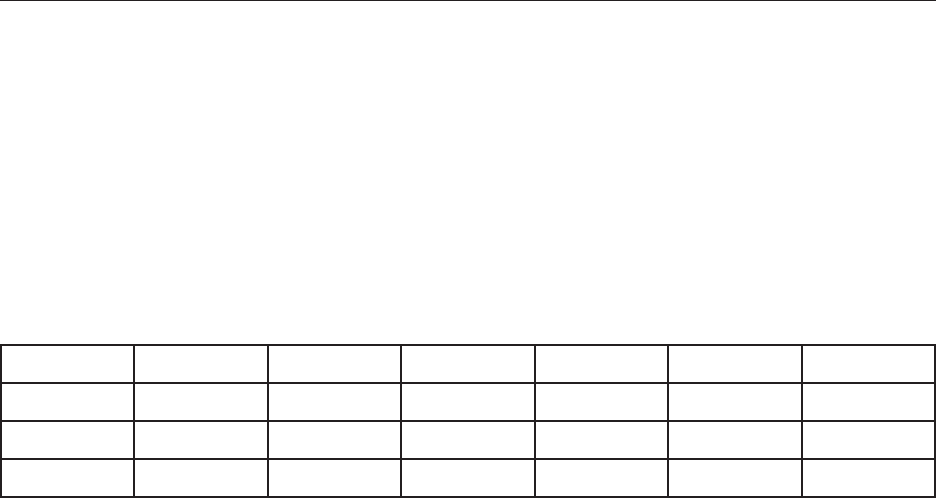
CHAPTER 4: ITEM ANALYSIS AND INTERPRETATION OF RESULTS24
EXAMPLE ITEMS AND ANALYSIS
e following are example item analysis results from ve items; each illustrates a common scenario. e item text is
not presented here, only the analysis. For each example, students were divided into High and Low groups based on
being in the top 25% and bottom 25% of performance on the total test (where performance includes the item in ques-
tion). Typically, item analysis output includes all the estimates mentioned in this chapter—comparative grouping of
students, a measure of item diculty, a measure of discrimination, and responses by option to allow for option analy-
sis. For each sample item below, the percentage of test-takers in the High and Low groups selecting each option is
shown. e total row shows the percentage of the total group who selected each option.
Interpretation (Item #1): e asterisk on option B indicates that B was keyed as the correct answer, but only 2% of the
students answered correctly, and only 1% of the High group answered correctly. is is the typical option pattern ob-
served for an item that is miskeyed. If the answer is truly option B, the item is very dicult and the discrimination
index is negative. e correct answer is almost certainly C, but a content expert should review the item for verica-
tion. If the correct answer is keyed as C, the P-value becomes 76% and the discrimination index becomes positive.
ese are both excellent values from a statistical perspective, and there is no reason to make any further changes be-
fore scoring the item or using it in future tests.
GROUP A B* C D E F
HIGH 1 1 91 4 1 2
LOW 20 6 51 14 6 3
TOTAL 9 2 76 8 3 2
Item #1
P-value: 2 discrimination index: -.21
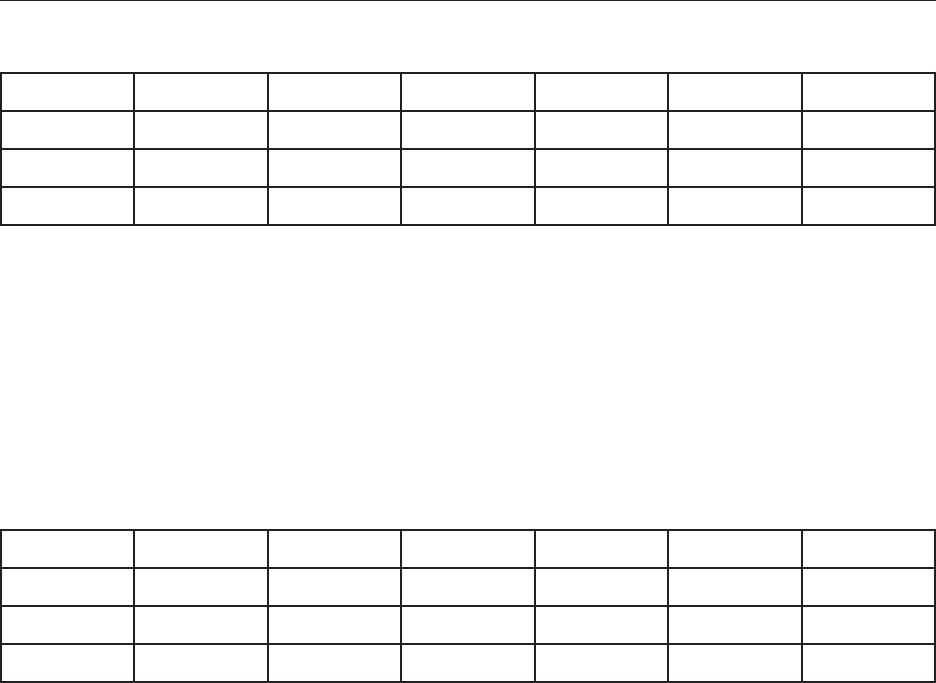
CHAPTER 4: ITEM ANALYSIS AND INTERPRETATION OF RESULTS 25
Interpretation (Item #2): 90% of the High group and 60% of the Low group selected the correct answer, with an over-
all percent-correct of 74%. ese are good statistics, because this item is of appropriate diculty and does a good job
of discriminating between those who know the material and those who don’t. e responses to the keyed option (C)
suggest the same. One conclusion of the option analysis is that A and B do not appear to be very plausible or useful
distractors, so these could potentially be rewritten for future versions of the item. Keep in mind that revising options
to make them more plausible can change the diculty of the item.
Interpretation (Item #3): 50% of the High group and 21% of the Low group selected the correct answer. is is a di-
cult item, and so a content expert should review it to ensure that the key is correct—there is the potential for option
A to be a second correct answer. If the item was not intended to be this dicult, it is important to review the struc-
ture of the item, as there may be aws that make the item confusing for the test-taker. However, if the item was in-
tended to be this dicult and the content expert agrees that the keyed option is the single correct answer, the item
can be scored as is.
GROUP A B C* D E F
HIGH 0 1 90 3 3 3
LOW 0 1 60 25 8 6
TOTAL 0 1 74 12 7 6
Item #2
P-value: 74 discrimination index: +.33
GROUP A B C* D E F
HIGH 44 1 50 2 1 2
LOW 20 15 21 22 20 2
TOTAL 32 7 34 14 11 2
Item #3
P-value: 34 discrimination index: +.30
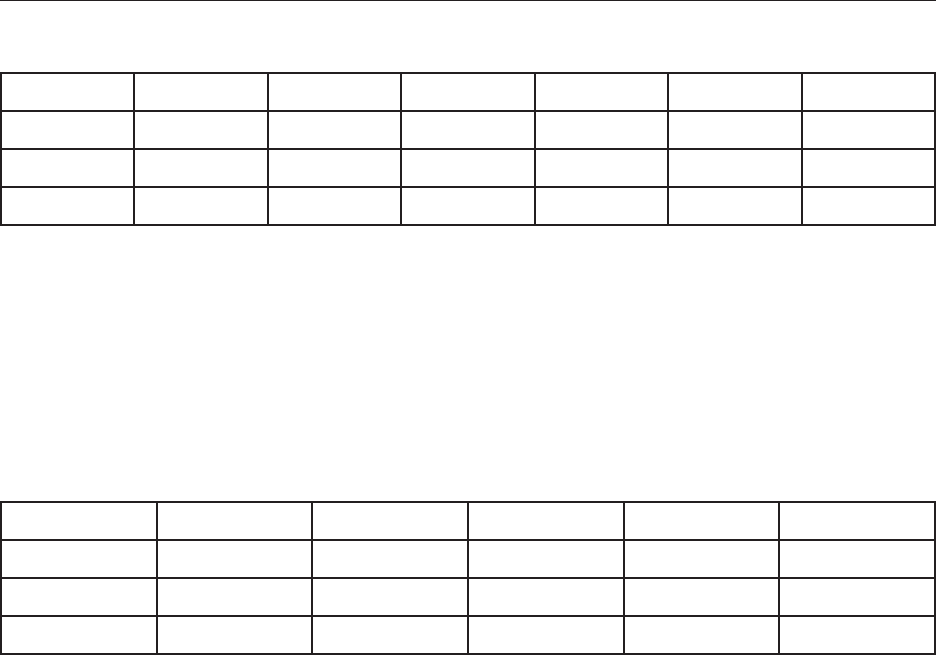
CHAPTER 4: ITEM ANALYSIS AND INTERPRETATION OF RESULTS26
Interpretation (Item #4): e High/Low group breakdown on option C is identical to Item #3, but this item is less
likely to have potential problems. In contrast to the previous sample item, those test-takers who don’t know the cor-
rect answer are more evenly spread across the other distractors. For the three distractors, A, B, and D, more test-tak-
ers in the Low group chose the distractor than test-takers in the High group. Of course, if the item was not intended
to be dicult, it would still be desirable to review options A, B, and D for correctness and clarity.
Interpretation (Item #5): e P-value is low and the discrimination is negative, indicating that there is a problem with
the item. Both the High and Low groups are more likely to select option B than the option keyed as correct, which is
D. is is a classic example of an item that likely has two correct answers. is item should be reviewed by a content
expert and should not be scored until it is reviewed, since something about the item stem or options is convincing
even the High performers that the key is an answer other than D.
GROUP A B C* D E F
HIGH 18 10 51 17 2 2
LOW 24 24 21 25 4 2
TOTAL 22 17 34 22 3 2
Item #4
P-value: 34 discrimination index: +.30
GROUP A B C D* E
HIGH 10 43 5 40 2
LOW 23 36 12 26 3
TOTAL 17 43 7 31 2
Item #5
P-value: 31 discrimination index: −.09

Section 2:
Writing One-Best-Answer
Items for the Foundational
(Basic) and Clinical Sciences

29
Rule 1: Each item should focus on an important concept or testing point.
As a healthcare provider and educator assisting in the development of an examination, you may be asked to write
items to assess test-taker knowledge of a particular domain. What do you want the test-taker to know or demon-
strate? e topic of the item usually results from the blueprint, which is the outline of the major topics to be covered
on the examination. For instance, if an examination is developed to assess knowledge of the cardiovascular system,
the blueprint might have two dimensions: 1) disease-based (e.g., hypertension, ischemic heart disease, systolic heart
failure), and 2) task-based (e.g., assessment of foundational science principles, diagnosis, history, prognosis). e
blueprint would likely include items along both dimensions, and might call for six items on hypertension, four on
systolic heart failure, two on diastolic heart failure, ten on ischemic heart disease, and so on. Along the task dimen-
sion there might be a similar distribution of topics. A clear and comprehensive blueprint or other set of test specica-
tions should always be available so that item writers can stay focused on the important topics and write sucient
numbers of items for each topic.
Rule 2: Each item should assess application of knowledge, not recall of an isolated fact.
e rst step in writing an item is to develop an appropriate stimulus to introduce the topic, such as a clinical or ex-
perimental vignette, to provide context to the question being asked. If there is no such stimulus, the resulting item
will generally be assessing knowledge recall. ese types of items make it dicult for the educator to assess any
higher level within Bloom’s taxonomy, such as “application of knowledge.” For instance, an item consisting of one sen-
tence, “Which of the following medications is used to decrease preload in systolic heart failure?” would assess only
the recall on the mechanisms of action of a list of pharmacotherapeutic agents.
It can be helpful to use actual cases previously encountered as a source of ideas for items and vignettes. However, you
should avoid relying on or adhering too closely to actual patient cases because these oen have atypical features that
may divert from a typical or representative case and lead to confusion. Additionally, in some instances, such as the
example with systolic heart failure, there will be an additional step that you must keep in mind: you should consider
the underlying cause of the heart failure. Patient demographics, past medical history, and other factors will dier de-
pending on the etiology of the condition. Patients with systolic heart failure from a viral cardiomyopathy versus from
ischemic heart disease may have dierent demographics and a dierent history; e.g., a younger patient with a viral ill-
ness preceding the onset of heart failure symptoms as compared to an older patient with risk factors for ischemic
heart disease.
Chapter 5: Basic Rules for Writing One-Best-Answer Items

CHAPTER 5: BASIC RULES FOR WRITING ONE-BEST-ANSWER ITEMS30
e details of the vignette should be guided by the level of the test-taker. A systolic heart failure vignette for a novice,
such as a second-semester rst-year medical student, would include very typical features and classic symptoms:
shortness of breath with physical activity that improves with rest; awakening at night short of breath, relieved by sit-
ting up; pedal edema; and pertinent negatives such as the absence of chest pain. Risk factors might include an upper
respiratory illness two weeks ago, or a history of heavy alcohol ingestion over 20 years. For more advanced test-tak-
ers, such as those sitting for a specialty certifying examination, the vignette could include some atypical features, as is
the case with many actual patients. e demographic information may or may not be signicant for the more ad-
vanced test-takers. For instance, every patient lives somewhere and many will have a current or past occupation that
may or may not be related to the cause of their illness. In a vignette for a 30-year-old man with shortness of breath
and wheezing in which the diagnosis is asthma, the demographic information might or might not be related to the
diagnosis. e patient might be a farmer, but the most likely diagnosis is still asthma and not farmer’s lung or silo-
ller’s lung.
Rule 3: e item lead-in should be focused, closed, and clear; the test-taker should be able to answer the item
based on the stem and lead-in alone.
e next step is to ask the question with the use of a lead-in, and the accompanying vignette allows lead-ins to be fo-
cused on the patient, such as, “Which of the following is the next step in the management of this patient?” or “Which
of the following is the most likely diagnosis?” An open-ended lead-in such as, “e diagnosis in the patient is:”
should be avoided. e lead-in should be a single, closed, clear question. Ideally, aer reading the vignette and the
lead-in, a test-taker should be able to answer the item without seeing the options. Another reason to use a closed
lead-in is because it helps to avoid certain item aws, such as grammatical cueing.
Rule 4: All options should be homogeneous and plausible, to avoid cueing to the correct option.
Next, generate the correct or keyed answer for the lead-in. For questions regarding diagnosis, the topic area may be
the answer—if you are assigned to write two items on community acquired pneumonia (CAP), one item on the diag-
nosis and one item on management, the assignment has already generated the keyed answer for the lead-in, “Which
of the following is the most likely diagnosis?” Oen, generating the correct answer is the easier step; generating plau-
sible and parallel yet incorrect distractors is more challenging. For example, reasonable distractors in an item where
the correct diagnosis is CAP could include pulmonary embolus, lung cancer, and pneumothorax.

CHAPTER 5: BASIC RULES FOR WRITING ONE-BEST-ANSWER ITEMS 31
Rule 5: Always review items to identify and remove technical aws that add irrelevant diculty or benet savvy
test-takers.
Once you have written your item, you should take a step back and look closely at its structure. e bulk of the text
(vignette or case information) should precede rather than follow the lead-in. e clinical or experimental
vignette should make sense and follow a logical sequence: rst list patient demographics, then history, physical exam-
ination, laboratory data, and so on. e lead-in should be closed, and the wording of the lead-in should logically gen-
erate a homogeneous option set. e use of a template to ensure all of these sections are in place and correctly
structured is highly recommended. As you review your item, ask yourself the following questions. If the options
were removed, could a knowledgeable test-taker answer the question correctly? Is there anything in the phrasing or
text that would confuse the knowledgeable test-taker? Are there any clues to help a testwise student guess the item
correctly? Finally, you should ask a colleague to review the items you have written, in particular for content, clarity,
and appropriateness for your particular test-taker population.

33
CHOOSING THE TOPICS TO TEST
e content of an exam should be driven by the purpose of that exam and the test-taker population. Who is being
tested and how will the scores be used? For example, the USMLE system is designed for use by state medical licens-
ing authorities in their decision to grant a general licensure for allopathic and international graduate physicians in the
United States. e focus is to assess knowledge of content that is necessary for the practice of medicine by the undif-
ferentiated physician; items might be included on USMLE that assess knowledge not uniformly taught in medical
school. Conversely, topics that are the focus in some medical schools might be omitted from the exam. e analogy
for individual schools and courses within schools is to determine the student test-taker population and purpose of
the scores. An exam that is intended for formative feedback at a mid-point of a course will have a dierent focus and
dierent content than an exam to determine end-of-clerkship grades.
WRITING CLINICAL VIGNETTES
As mentioned previously, in addition to considering topics that are important to include on a test, the item writer
should think about how to structure those questions to test more than just recall of isolated facts. Traditionally, test
questions have been classied as requiring recall, interpretation, or problem solving (memory, comprehension, and
reasoning), depending on the cognitive processes required to answer the question. Typical denitions of “Recall
Questions” are those that assess student knowledge of denitions or facts. “Interpretation Questions” require students
to review some information (e.g., a vignette), and reach some conclusion, such as a diagnosis. “Problem-Solving
Questions” present a situation and require students to take some action (e.g., decide the next step in patient manage-
ment). e diculty with these classications is that the cognitive processes required to answer a question are as de-
pendent on the background of the student as they are on the question content. Additionally, the selection of item
types depends on the intent of their use: for a medium- to high-stakes summative examination, the use of vignettes
that require higher-order thinking skills and application of knowledge would be preferable to simple recall items. Use
of recall items may be best utilized for formative assessment purposes and the evaluation of simpler concepts that
might not lend themselves to clinical or experimental scenarios (see Figure 1 for the advantages of each item type in
each assessment type).
Chapter 6: Testing Application of Foundational (Basic)
and Clinical Knowledge
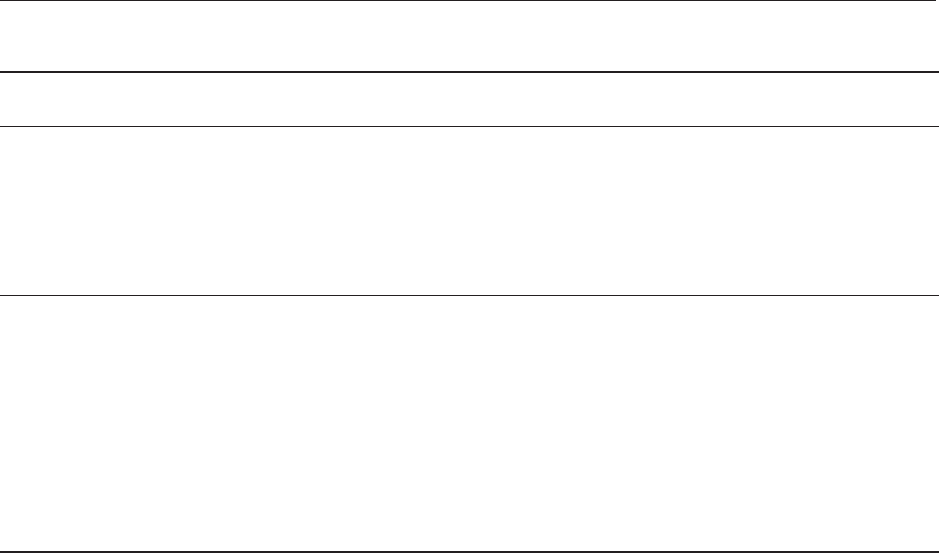
CHAPTER 6: TESTING APPLICATION OF FOUNDATIONAL (BASIC) AND CLINICAL KNOWLEDGE34
Experts in a content area may simply recall an answer with little or no conscious thought, whereas others may need to
reason out the answer from basic principles. e cognitive processes involved in responding to a question are stu-
dent-specic, making the taxonomic approach dicult to use. An alternate approach divides items into two cate-
gories: application of knowledge vs. recall of a fact. If a question requires a test-taker to reach a conclusion, make a
prediction, or select a course of action, it is classied as an application of knowledge question. If a question assesses
only rote memory of a fact (without requiring its application), it is classied as a recall question.
Figure 1. Promoting Versatility in Item Creation: Recall vs. Vignette
ITEM TYPE FORMATIVE ASSESSMENT SUMMATIVE ASSESSMENT
Recall • Useful for assessing eciency • Allows for large quantity of items
of classroom instruction • Best for single-step questions and
• Provides “rapid re” single concepts/facts
stimulation of learning
• Attention-keeping strategy
Vignette/Experimental • Item format familiarization • Good for assessing
• Problem-based learning higher-order thinking skills
• Team-based learning • Provides better approximation
• Clinical or experimental of real-life practice
correlations during • Allows for integration and
instruction dierentiation
• Amenable to multi-step question
formats
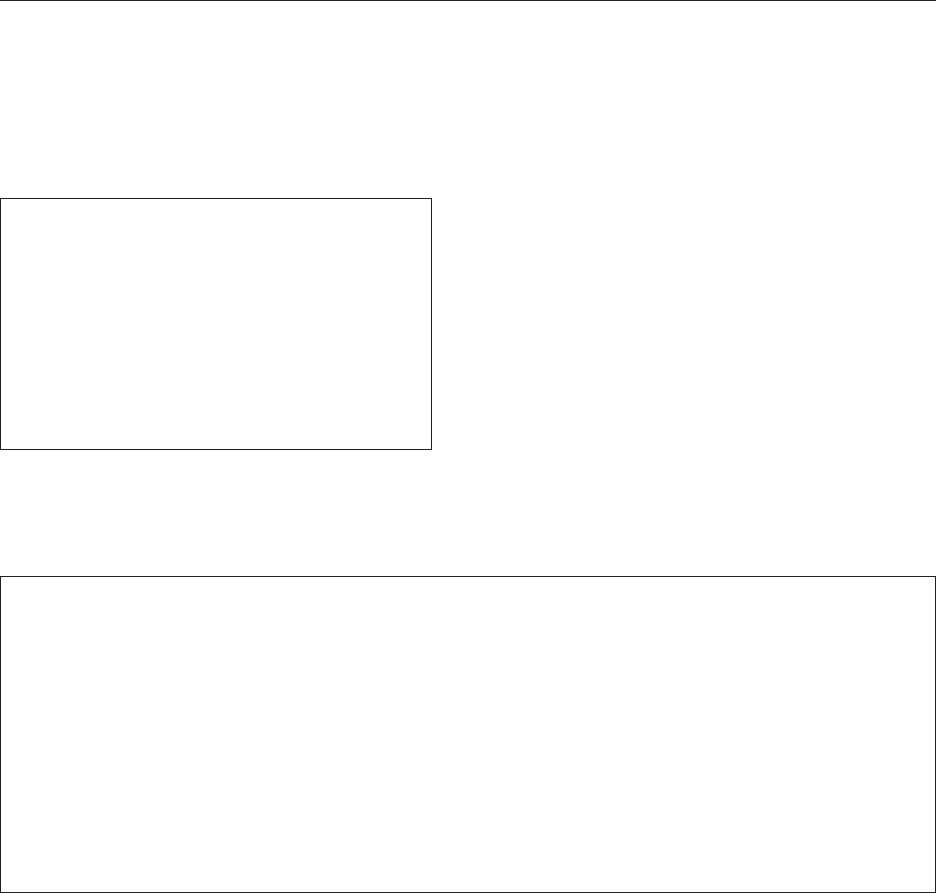
CHAPTER 6: TESTING APPLICATION OF FOUNDATIONAL (BASIC) AND CLINICAL KNOWLEDGE 35
Items asking for recall of isolated facts oen begin by citing a disease and then asking what patient ndings are expected.
For example, “Which of the following ndings is most likely to be seen in postsurgical patients with pulmonary em-
bolism?” is an item structured similarly to most textbook questions; the test-taker could look up the disease and nd the
answer in a single paragraph. From a practical standpoint, these items seem clinically backwards – patients rarely tell
their physician what disease they have and then ask the physician to determine the signs and symptoms.
In contrast, the following item describes a patient and asks which study is most appropriate. e inclusion of the
vignette leads to a more realistic task, because the test-taker would need to be able to both recall specic information
and synthesize that information to know which studies should be ordered.
A 28-year-old primigravid woman is at 11 weeks’ gestation. Medical history is unremarkable. Family history is unre-
markable except that both of her brothers have intellectual developmental disorder, her mother died of breast cancer
at age 55, and her father is estranged. No family health records are available. Which of the following studies is ap-
propriate?
A. Amniocentesis for
α
-fetoprotein
B. Blood test for fragile X carrier status
C. Blood test for phenylketonuria carrier status
D. Chorionic villus sampling for chromosome analysis
E. Chorionic villus sampling for Duchenne’s muscular dystrophy
Which of the following is an indication for fetal
karyotyping in a 28-year-old woman?
A. Fetal cystic hygroma on ultrasound exam
B. Paternal age 55
C. Previous child with spina bifida
D. Previous miscarriage of a triploid fetus
E. Trisomy 21 in the woman’s brother
Another type of recall item is known as the “waiting room
item.” Here, the test-taker is asked to select one of ve pa-
tients for whom fetal karyotyping is most appropriate, al-
most as if he or she is charged with performing fetal
karyotyping on someone and needs only to look into the
waiting room and select the patient who is most appropriate.

CHAPTER 6: TESTING APPLICATION OF FOUNDATIONAL (BASIC) AND CLINICAL KNOWLEDGE36
Questions with a clinical vignette as part of the item stem have several benets. First, the authenticity of the examina-
tion is greatly enhanced by using questions that require test-takers to “solve” clinical problems. Second, the questions
are more likely to focus on important information, rather than trivia. ird, these questions help to identify those
test-takers who have memorized a substantial body of factual information but are unable to use that information ef-
fectively in clinical situations.
Writing application of knowledge questions is relatively straightforward in the clinical sciences. e one instance in
which use of a clinical vignette involves simple recall of an isolated fact is if the vignette describes a patient identical
to one the student previously has read about or has participated in the patient’s care (e.g., using a patient vignette
from a textbook or one discussed in class).
GUIDELINES FOR CLINICAL VIGNETTE CONTENT
• Test application of knowledge using clinical vignettes to pose medical decisions in patient care situations
• Focus items on common or potentially catastrophic problems; avoid “zebras” and esoterica
• Pose clinical decision-making tasks that would be expected of a successful test-taker
• Avoid clinical situations that would be handled by a specialist if not writing for a specialty exam
• Focus on specic tasks that the successful test-taker must be able to undertake at the next stage of training
• Focus on areas in which clinical reasoning mistakes are oen made
e following can be used as a template for a patient vignette; not all of the following components are necessary, but
when present should be in the order indicated:
• Age, gender (e.g., 45-year-old man)
• Site of care (e.g., the emergency department)
• Presenting complaint (e.g., headache)
• Duration of complaint (e.g., 2 days)
• Patient history, including past medical history, family history, psychosocial history,
and review of systems if important and plausible for the scenario
• Physical ndings
• Results of diagnostic studies
• Initial treatment, subsequent ndings

CHAPTER 6: TESTING APPLICATION OF FOUNDATIONAL (BASIC) AND CLINICAL KNOWLEDGE 37
Make sure the item stems adhere to the following rules:
• Focuses on important concepts rather than trivial facts
• Can be answered without looking at the options
• Includes all relevant facts; no additional data should be provided in the options
• Is not “tricky” or overly complex
• Is not negatively phrased (e.g., avoid using except or not in the lead-in)
WRITING ITEM LEADINS SEE APPENDIX B FOR MORE DETAIL
e vast majority of items should be written with a clinical or experimental vignette. e stem should begin with the
presenting problem of a patient, followed by the history (including duration of signs and symptoms), physical nd-
ings, results of diagnostic studies, initial treatment, subsequent ndings, and so on. Each vignette may include only a
subset of this information, but the information should be provided in a consistent order across items. e stem
should consist of a single, clearly formulated question. e lead-in of the stem must pose a clear question so that the
test-taker can answer without looking at the options. As mentioned previously, satisfying the “cover-the-options” rule
is an essential component of a good question. e following stem provides sucient information and can be an-
swered without referring to the options.
A 52-year-old man has had increasing dyspnea and cough productive of purulent sputum for 2 days. He has smoked
one pack of cigarettes daily for 30 years. His temperature is 37.2° C (99° F). Breath sounds are distant with a few
rhonchi and wheezes. Leukocyte count is 9000/mm
3
with a normal differential. Gram stain of sputum shows numerous
neutrophils and gram-negative diplococci. X-ray films of the chest show hyperinflation. Which of the following is the
most likely diagnosis?
ITEM EXAMPLE WITH AND WITHOUT VIGNETTE
e following trio of items were administered on USMLE and performed quite dierently across the various formats,
especially for low-performing test-takers. e grid under each item shows the percentage of High (top 20%) and Low
(bottom 20%) students who selected each option. Almost all of the High group (99%) and the Low group (90%) se-
lected the correct option (indicated by the asterisk) in the non-vignette format. e short- and long-vignette formats
were not markedly more dicult for the High group, but were for the Low group; the correct answer was selected by
82% of the Low group in the short-vignette format and 66% in the long-vignette format. See Chapter 4 for a more in-
depth discussion of item analysis.
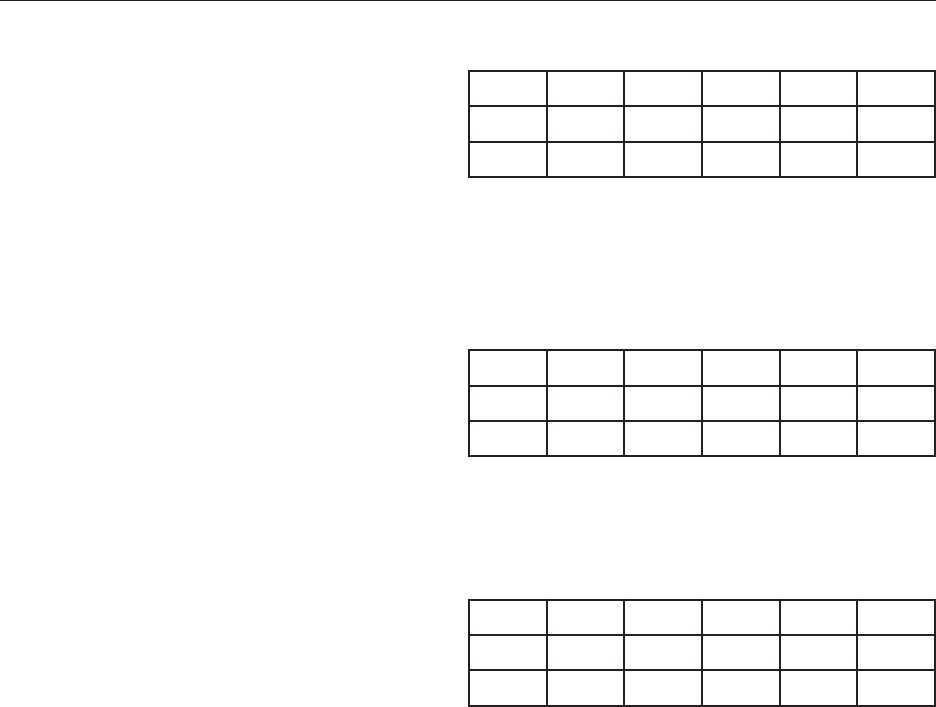
CHAPTER 6: TESTING APPLICATION OF FOUNDATIONAL (BASIC) AND CLINICAL KNOWLEDGE38
No Vignette
The most likely renal abnormality in children with
nephrotic syndrome and normal renal function is
A. acute poststreptococcal glomerulonephritis
B. hemolytic-uremic syndrome
C. minimal change nephrotic syndrome*
D. nephrotic syndrome due to focal and
segmental glomerulosclerosis
E. Schönlein-Henoch purpura with nephritis
Short Vignette
A 2-year-old child has a 1-week history of edema. His
blood pressure is 100/60 mm Hg, and there is general-
ized edema and ascites. Serum concentrations are: crea-
tinine 0.4 mg/dL, albumin 1.4 g/dL, and cholesterol 569
mg/dL. Urinalysis shows 4+ protein and no blood.
Which of the following is the most likely diagnosis?
(Same option set as above)
Long Vignette
A 2-year-old child developed swelling of his eyes and
ankles over the past week. Blood pressure is 100/60
mm Hg, pulse 110/min, and respirations 28/min. In ad-
dition to swelling of his eyes and 2+ pitting edema of
his ankles, he has abdominal distention with a positive
fluid wave. Serum concentrations are: creatinine 0.4
mg/dL, albumin 1.4 g/dL, and cholesterol 569 mg/dL.
Urinalysis shows 4+ protein and no blood. Which of
the following is the most likely diagnosis?
(Same option set as above)
A B C* D E
HIGH 1 0 99 0 0
LOW 8 1 90 1 0
A B C* D E
HIGH 0 0 98 2 0
LOW 6 2 82 9 1
A B C* D E
HIGH 0 1 98 1 0
LOW 10 9 66 10 5

CHAPTER 6: TESTING APPLICATION OF FOUNDATIONAL (BASIC) AND CLINICAL KNOWLEDGE 39
Although the third item listed is labeled “long vignette,” it is still relatively short in length. Clinical knowledge and
science exams require test-takers to demonstrate prociency in sorting through patient information, synthesizing the
important ndings, and reaching a conclusion. As a result, these items may have extraneous information as well as
the essential information to answer the question. If there is concern about the vignette length, it is possible to synthe-
size ndings with a statement such as, “e family history is noncontributory.”
ADDITIONAL POINTS ON VIGNETTES
Verbosity, Window Dressing, and Red Herrings
Many educators stress the importance of writing items that are as short as possible, as a method of avoiding excessive
verbosity, “window dressing” (extraneous material not needed to answer the item), and “red herrings” (information
designed to mislead the test-taker). However, it is possible to avoid these traps while writing good-quality clinical
vignettes that stress application of knowledge by asking test-takers to make clinical decisions, rather than to simply
recall isolated facts. ese items are designed to reect “real-life tasks” by challenging test-takers to rst identify the
ndings that are important, and then integrate those ndings into a diagnosis or clinical action. ese items oen re-
quire multiple steps in the cognitive process. e vignettes tend to follow a standard structure and pose questions that
are clinically natural, and the use of a template allows for development of high-quality vignettes with a lower risk of
adding too much verbiage or unnecessary or confusing information.
Use of Real Patients
As mentioned previously, item writers should be careful when basing vignettes on real patients, particularly for tests
aimed at students. As a general rule, real patients are complicated, and the elements that are complicated are not al-
ways those that are important for assessment. As noted earlier, it is ne to sometimes include window dressing, such
as incidental ndings, but item writers should note that real patients oen have “red herrings” among their ndings.
Patients Who Lie
Ideally, patients in vignettes should tell the truth, or the physician’s interpretation of the patient’s story should be pro-
vided. Physicians use multiple cues to determine how truthful a patient is and many of these cues cannot be trans-
lated into written form. us, an item may describe a patient’s alcohol consumption as, “e patient drinks 16 ounces
of beer with dinner each night” or, “e patient’s description of his alcohol consumption is contradictory.” Do not
write something that requires an interpretation of veracity, such as, “e patient ‘claims’ to drink only one bottle of
beer each night.”

CHAPTER 6: TESTING APPLICATION OF FOUNDATIONAL (BASIC) AND CLINICAL KNOWLEDGE40
STRUCTURING ITEMS TO FIT TASK COMPETENCIES
A set of dened task competencies will assist the item writer in focusing his or her intended testing point. Each com-
petency requires a slightly dierent approach to item writing. Some sample lead-ins and example items to guide item-
writing eorts for each physician (or other provider) task competency are provided below. Additional lead-ins can be
found in Appendix B, Sample Lead-Ins Based on Provider Task Competencies.
Foundational (Basic) Science
Foundational science comprises items that require understanding and application of basic science. ese items
should require clinical knowledge as well as knowledge of one or more foundational science principles that would
likely have been learned during preclinical study and reinforced during clinical rotations. e following lead-ins are
examples of those used in this category:
• Which of the following is the most likely cause/mechanism of this eect?
• Which of the following is the most likely causal infectious agent?
• is patient most likely has a defect in which of the following?
• is patient most likely has a deciency in which of the following enzymes?
• Which of the following cytokines is the most likely cause of this condition?
• Which of the following structures is at greatest risk for damage during this procedure?
• e most appropriate medication for this patient will have which of the following mechanisms of action?
Diagnosis
e diagnosis competency is subcategorized into more detailed concepts: Obtaining and Predicting History and
Physical Examination, Selecting and Interpreting Diagnostic Studies, Formulating the Diagnosis, and Determining
Prognosis/Outcome. Sample lead-ins for the various subcategories are shown.
Obtaining and Predicting History and Physical Examination
• Which of the following factors in the patient’s history most increased her risk for developing this condition?
• Which of the following additional information regarding this patient’s history is most appropriate to
obtain at this time?
• Which of the following is the most appropriate focus of the physical examination at this time?

CHAPTER 6: TESTING APPLICATION OF FOUNDATIONAL (BASIC) AND CLINICAL KNOWLEDGE 41
Selecting and Interpreting Diagnostic Studies
• Which of the following is the most appropriate diagnostic study to obtain at this time?
• Which of the following laboratory studies is most likely to conrm the diagnosis?
• Which of the following is the most likely explanation for these laboratory ndings?
• Arterial blood gas analysis is most likely to show which of the following sets of ndings?
Formulating the Diagnosis
• Which of the following is the most likely diagnosis?
• Which of the following is the most likely working diagnosis?
Determining Prognosis/Outcome
• Based on these ndings, this patient is most likely to develop which of the following?
• Which of the following is the most likely complication of this patient’s current condition?
A 28-year-old woman has palpitations that occur approximately once a week, last 1 to 5 minutes, and consist of rapid,
regular heart pounding. The episodes start and stop suddenly and have not been associated with chest discomfort or
dyspnea. There is no history of heart problems. She drinks two to three cups of coffee daily. She rarely drinks alcohol
and does not smoke. Her blood pressure is 120/88 mm Hg, and pulse is 96/min and regular. A stare and lid lag are
noted. The thyroid gland is firm and 1.5 times larger than normal. There is a midsystolic click at the apex and a grade
2/6 early systolic murmur at the left upper sternal border. An ECG is normal except for evidence of sinus tachycardia.
Which of the following is the most appropriate next step in diagnosis?
A. Ambulatory ECG monitoring
B. Echocardiography
C. Measurement of serum thyroid-stimulating hormone level*
D. Measurement of urine catecholamine level
E. MUGA scan

CHAPTER 6: TESTING APPLICATION OF FOUNDATIONAL (BASIC) AND CLINICAL KNOWLEDGE42
Management
e management competency contains a range of concepts, such as Health Maintenance and Disease Prevention,
Pharmacotherapy, and Clinical Interventions/Treatment. In most items that focus on the testing point of manage-
ment, the patient’s diagnosis is inferred so that the appropriate management can be determined.
Health Maintenance and Disease Prevention: Items in this topic area assess the ability to evaluate risk factors, under-
stand epidemiologic data, and apply preventive measures. Health Maintenance and Disease Prevention items com-
monly fall into one of the following categories: 1) screening tests, 2) constructive interference, 3)
immunizations/travel medicine, or 4) emergency intervention. In general, the writer should open the items with a
clinical vignette that describes a patient. In addition to physical examination ndings, these vignettes may include in-
formation about immunization history, risk factors, and family history. Information about the community may be
relevant and therefore included, but the question should focus on the individual patient. Questions should NOT
focus on the direct assessment of isolated facts. For example, avoid asking about the leading cause of death in some
subpopulation; instead, focus on the application of this knowledge. In asking about immunizations or screening tests,
consider providing a chart of customary practices to avoid memorization of conicting recommendations. e fol-
lowing lead-ins are examples of those used in this category:
• Which of the following immunizations should be administered at this time?
• Which of the following is the most appropriate screening test?
• Which of the following tests would have predicted these ndings?
• Which of the following is the most appropriate intervention?
• For which of the following conditions is this patient at greatest risk?
• Which of the following is most likely to have prevented this condition?
• Which of the following is the most appropriate next step in management to prevent
[morbidity/mortality/disability]?
• Which of the following should be recommended to prevent disability from this patient’s injury/condition?
• Early treatment with which of the following is most likely to have prevented this patient’s condition?
• Supplementation with which of the following is most likely to have prevented this patient’s condition?

CHAPTER 6: TESTING APPLICATION OF FOUNDATIONAL (BASIC) AND CLINICAL KNOWLEDGE 43
A 15-year-old boy has had two episodes of severe ana-
phylactic shock following bee stings. Which of the fol-
lowing is the most appropriate intervention?
A. Administration of corticosteroids during
the summer
B. Desensitization with bee venom extract*
C. Long-term prophylactic antihistamine
therapy
D. Protective clothing
E. Restrict him to the house during the
summer months
A healthy, moderately active 75-year-old woman is
found on routine screening to have a total serum choles-
terol concentration of 208 mg/dL and serum HDL-cho-
lesterol concentration of 70 mg/dL. ECG shows no
abnormalities. Which of the following dietary recom-
mendations is most appropriate?
A. Decreased intake of cholesterol
B. Decreased intake of saturated fat
C. Decreased intake of simple carbohydrates
D. Increased intake of fiber
E. No change in diet*
A 33-year-old woman, gravida 1, para 1, spontaneously
delivers a 2460-g (5 lb 7oz) female newborn at 38
weeks’ gestation. The newborn has hepato-
splenomegaly, patent ductus arteriosus, and cataracts. At
8 weeks’ gestation, the mother developed a macu-
lopapular rash, enlarged cervical lymph nodes, sore
throat, and arthralgias that spontaneously resolved in 1
week. The subsequent prenatal course was uncompli-
cated. Which of the following tests during pregnancy
is most likely to have predicted the findings in the
fetus?
A. Amniocentesis to determine karyotype
B. Culture for herpes simplex virus
C. Serial rubella titers*
D. Urinalysis for cytomegalovirus
E. VDRL test
An asymptomatic 33-year-old man has a blood pressure
of 166/112 mm Hg. Serum electrolyte levels are within
normal limits. Effective antihypertensive treatment is
most likely to reduce the likelihood of which of the
following?
A. Aortic aneurysm
B. Congestive heart failure
C. Myocardial infarction
D. Renal failure
E. Stroke*

CHAPTER 6: TESTING APPLICATION OF FOUNDATIONAL (BASIC) AND CLINICAL KNOWLEDGE44
Pharmacotherapy/Clinical Interventions and Treatments: ese items assess principles of chronic and acute in inpa-
tient and outpatient care. When writing these items, it is especially important to focus on aspects of care relevant to
the level of practice of the test-taker (supervised, limited supervision, independent practice, subspecialist). Some
lead-ins that can be used are:
• Which of the following is the most appropriate initial or next step in patient care?
• Which of the following is the most eective management?
• Which of the following is the most appropriate pharmacotherapy?
• Which of the following is the rst priority in caring for this patient?
A hospitalized 55-year-old woman with decompensated
cirrhosis of the liver is being treated with spironolactone,
potassium chloride elixir, and furosemide. She is now
barely responsive and is hypotensive without respiratory
distress. She has signs consistent with chronic hepatic
disease, ascites, and minor peripheral edema. ECG
shows a regular, slow rhythm (55/min), no P waves, and
a wide, slurred QRS complex running into a wide, slurred
ST and T wave. Which of the following should be ad-
ministered intravenously?
A. Calcium*
B. Lidocaine
C. Magnesium
D. Potassium
E. 0.9% Saline
A previously healthy 15-year-old boy has cramping peri-
umbilical pain; after several hours, the pain shifts to the
right lower quadrant and becomes constant. He vomits
several times and is brought to the emergency depart-
ment. There is tenderness on deep palpation of ab-
domen in the right lower quadrant. Findings on chest
and abdominal x-ray films are normal. Leukocyte count
is 15,000/mm
3
. Urinalysis shows 3 leukocytes/hpf.
Which of the following is the most appropriate initial
management?
A. Barium enema
B. CT scan of the abdomen
C. Intravenous pyelography and cystography
D. Supportive treatment at home; return at
once if the pain increases
E. Surgical exploration of the abdomen*

CHAPTER 6: TESTING APPLICATION OF FOUNDATIONAL (BASIC) AND CLINICAL KNOWLEDGE 45
Mechanisms of Disease
e items in this competency should evaluate test-takers’ knowledge of pathophysiology in its broadest sense, includ-
ing etiology, pathogenesis, natural history, clinical course, associated ndings, complications, severity of illness, and
intended or unintended eects of therapeutic interventions. ese items should be framed in a clinical context. In
general, the writer should open items on mechanisms of disease with a clinical vignette of a patient and his/her symp-
toms, signs, history, and lab study ndings, and use lead-ins such as the following:
• Which of the following is the most likely explanation for these ndings?
• Which of the following is the most likely location of this patient’s lesion?
• Which of the following is the most likely pathogen?
• Which of the following ndings is most likely to be increased/decreased?
• A biopsy specimen is most likely to show which of the following?
A 10-year-old girl develops gross hematuria 14 days
after a sore throat. She has a blood pressure of 170/100
mm Hg and 2+ pedal and pretibial edema. Serum urea
nitrogen (BUN) level is 3.2 mg/dL. Which of the follow-
ing is the most likely cause?
A. Acute postinfectious glomerulonephritis*
B. Microscopic polyangiitis
C. Minimal change disease
D. Thin basement membrane nephropathy
E. Tubulointestinal nephritis
A 32-year-old man has a purulent urethral discharge. A
culture grows
Neisseria gonorrhoeae
sensitive to peni-
cillin. One week after cessation of penicillin therapy, the
patient has a recurrence of the urethral discharge. A cul-
ture again shows
N. gonorrhoeae
sensitive to penicillin.
Both the patient and his sexual partner are HIV negative.
Examination of the patient’s sexual partner shows an
anal fissure; urethral culture does not grow
N. gonor-
rhoeae.
Which of the following is the most likely cause
of the recurrence of urethral infection?
A. Concurrent herpesvirus infection
B. Emergence of bacterial resistance
C. Inadequate treatment with penicillin
D. Reinfection from sexual partner*

CHAPTER 6: TESTING APPLICATION OF FOUNDATIONAL (BASIC) AND CLINICAL KNOWLEDGE46
WRITING ITEMS ON DIFFICULT TOPICS
A common belief is that many topics do not lend themselves to a multiple-choice format. When working with di-
cult topics, it can be helpful to review sources of test material and select any questions on the topic that you think are
acceptable. Next, identify the key features of these items and try to develop a template that would enable others to
write similar items. For topics where no sample items are available, think about what you want to assess. Go beyond
the list of topics by outlining tasks related to the topic that are essential for medical students to know.
To illustrate this process, the following paragraphs outline a process similar to one that was used to write NBME
items on medical ethics and jurisprudence. e content outline included the following topics: 1) consent and in-
formed consent to treatment (e.g., full disclosure, alternate therapies, risks and benets, conict of interest); 2) physi-
cian-patient relationship (e.g., boundaries, truth-telling, condentiality including HIPAA, privacy, autonomy, justice,
benecence); 3) death and dying and palliative care (e.g., diagnosing death, life-support, organ donation, and
euthanasia and physician-assisted death); 4) legal issues related to abuse (e.g., child, elder, intimate partner); 5) birth-
related issues; and 6) research issues (e.g., consent, placebos, conict of interest, vulnerable populations).
Aer reviewing the item pool, the NBME decided that it was not important to assess whether students know deni-
tions; instead, the goal became assessment of whether or not test-takers could apply ethical principles in their deci-
sions related to patient care. A group of item writers reviewed model questions and then generated new items for the
exam. All questions involved a patient vignette and required the student to indicate what the physician should do or
asked the student to evaluate the appropriateness of the physician’s actions indicated in the vignette. No questions fo-
cused just on the denition of terms. e following are two sample items that use genuine vignettes to test application
of knowledge.
The legal basis for the eased restrictions on abor-
tions in the United States can be traced most
closely to:
A. AMA rulings
B. a federal court ruling
C. federal legislation
D. state court rulings
E. state legislations
e diculty of this topic area tends to inuence item
writers to use simple recall items (“Which of the following
is the denition of informed consent?”) or “waiting room”
items (“Which ethical principle is being illustrated by the
scenario?”). is sample item shows why these were oen
irreverently referred to as “Who cares?” questions.

CHAPTER 6: TESTING APPLICATION OF FOUNDATIONAL (BASIC) AND CLINICAL KNOWLEDGE 47
A nurse is hospitalized for an appendectomy at the medical center where she is employed. One week after discharge,
the assistant hospital administrator asked the surgeon what the final diagnosis was. Which of the following is the
most appropriate response on the part of the surgeon?
A. Answer, because as an employee of the medical center the administrator has access to information
about patients
B. Answer, because it will expedite handling of insurance issues at the medical center
C. Answer, because of the possibility of spreading misinformation about the patient
D. Decline to answer, because the administrator is not a medical doctor
E. Decline to answer, because the information is confidential*
An 8-year-old boy with acute lymphoblastic leukemia has experienced three relapses in the past 2 years. The only avail-
able treatment is experimental chemotherapy. Without treatment, the child is unlikely to survive for more than 6
weeks; with treatment, his prognosis is unknown. The parents do not want further treatment for their son and wish to
take him home; the child also says he wants to go home. Which of the following is the most appropriate course of
action?
A. Discharge the child against medical advice
B. Discharge the child routinely*
C. Petition the court for an order for treatment
D. Report the parents to social services for medical neglect

49
e computer-based administration of a multiple-choice exam makes it straightforward to add media to test items.
ere are many advantages to adding media, most notably the opportunity that images, videos, and other media pro-
vide for adding authenticity to the assessment of knowledge and skills. While text-based vignettes are well-suited to
the assessment of the foundational and clinical sciences, it is clear to see how the addition of media can improve an
item that describes the appearance of a patient or a physical exam. In addition, the presence of media allows the item
writer to assess skills that purely text-based items cannot measure well (many noncognitive skills may fall into this
area). Finally, long clinical vignettes that fully describe the patient condition may be challenging to write without in-
cluding textual cues that benet the savvy test-taker. Using media in the place of this text not only provides authen-
ticity but also avoids giving the answer away in the description.
When writing test items that use media, the goal should be to select the media that best simulates what happens in
practice. ere are many media types for the item writer to consider. All the types presented in this chapter are ap-
propriate for assessment of foundational and clinical sciences, and many have been used in NBME exams. In order to
determine if a particular media type is a good simulation for what happens in practice, it is important to consider the
following:
• e content area covered or the skills being assessed: For example, if the topic area is about ndings on car-
diac auscultation, the image of an ECG is a natural t for that skill.
• e novelty of the media: Very novel media may require a learning curve or additional tutorial information
to orient the test-takers, so simplicity in accessing media is a desirable factor.
• e memorability of the media: Media may be more easily remembered by students, which can be problem-
atic if a limited sample of dierent images or videos is used for multiple classes or exams. Ideally, students
would not be able to easily memorize notable features of the test item and share that information with the
next set of test-takers (e.g., the patient with the moustache has aortic stenosis). One option for avoiding this
is to write multiple items for each piece of media.
• e richness of the patient description required: A long clinical vignette combined with media such as a
video clip can provide a rich description of the patient that is more authentic to clinical practice, as it re-
quires the students to interpret ndings. However, this item now requires more time for the student to ex-
plore the media before reviewing the options. Item writers should be aware of the trade-os between the
desirable level of richness and the additional time or eort required.
Chapter 7: Using Media as Part of Clinical Vignettes

CHAPTER 7: USING MEDIA AS PART OF CLINICAL VIGNETTES50
TYPES OF MEDIA
ere are several types of media commonly used in clinical science examinations:
• Images (static)
• Patient photographs
• Videos
• Interactive media (e.g., avatars)
Images
Radiographic studies, such as x-rays, CT scans, and MRIs, are common image types included in multiple-choice
questions. Students may be asked to interpret the studies and decide on a diagnosis or management plan. Two exam-
ples are shown here.
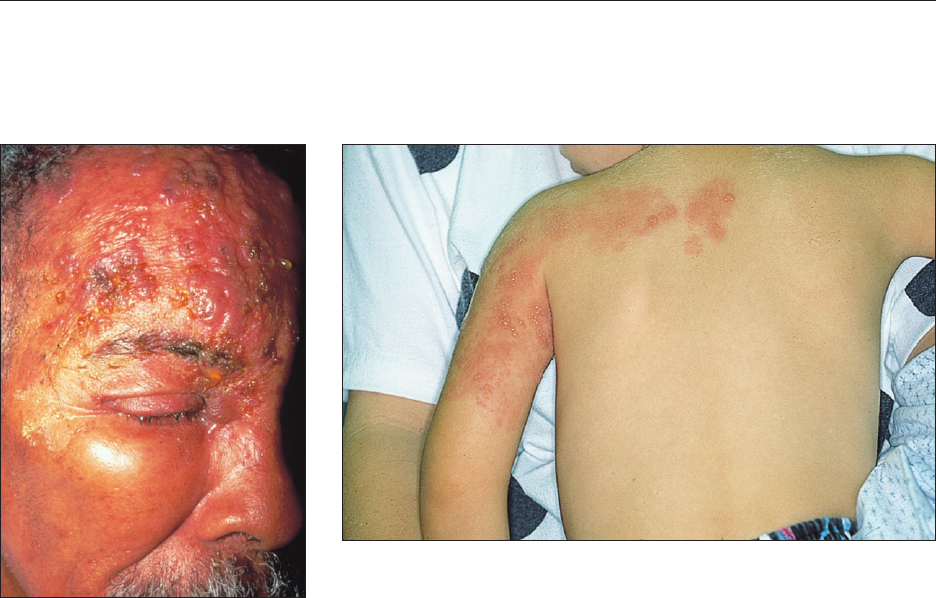
CHAPTER 7: USING MEDIA AS PART OF CLINICAL VIGNETTES 51
Patient Photographs
Patient photographs add authenticity and provide a means of conveying information accurately and succinctly to the
student. Two example photographs are shown here.
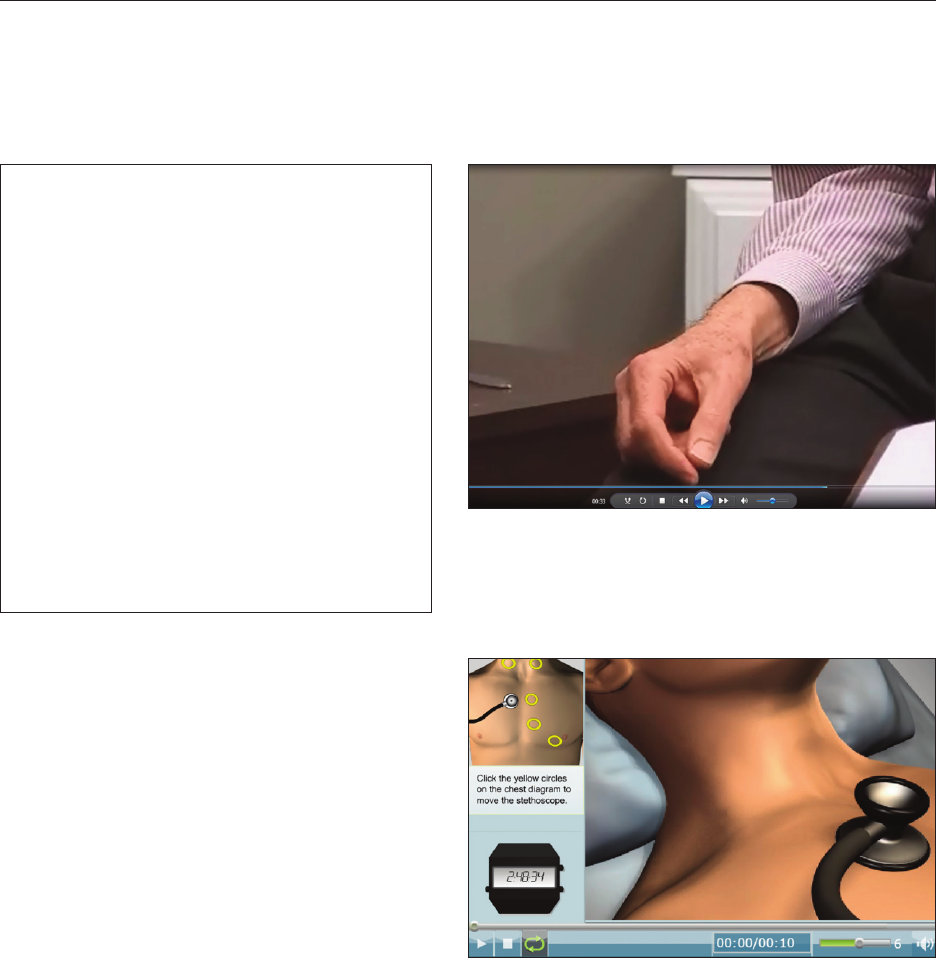
CHAPTER 7: USING MEDIA AS PART OF CLINICAL VIGNETTES52
Videos
Findings from a neurologic examination are much better shown than described. In general, videos can be useful to
show physical examination ndings as well as patient-doctor interactions. A screenshot of a video is shown below
with an accompanying item. e video shows the resting tremor of Parkinson’s disease.
Interactive Media
Media can also be interactive, requiring students to
select dierent areas to see and/or hear dierent ex-
amination ndings that are similar to actual examina-
tions. An example screenshot of an avatar simulating
placement of a stethoscope with corresponding heart
sound is shown here.
A 70-year-old man comes to the clinic because of dif-
ficulty writing over the past 3 months. He says that he
fell once without injury this past week. He works as
an accountant. He has a history of hypertension and
hyperlipidemia. His medications include hydro-
chlorothiazide and atorvastatin. His vital signs are
within normal limits. The remainder of the examina-
tion is remarkable only for the findings shown. Play
the video to view the exam. Which of the following
is the most likely diagnosis?
A. Benign essential tremor
B. Dementia, Alzheimer’s type
C. Parkinson’s disease*
D. Subclavian steal syndrome
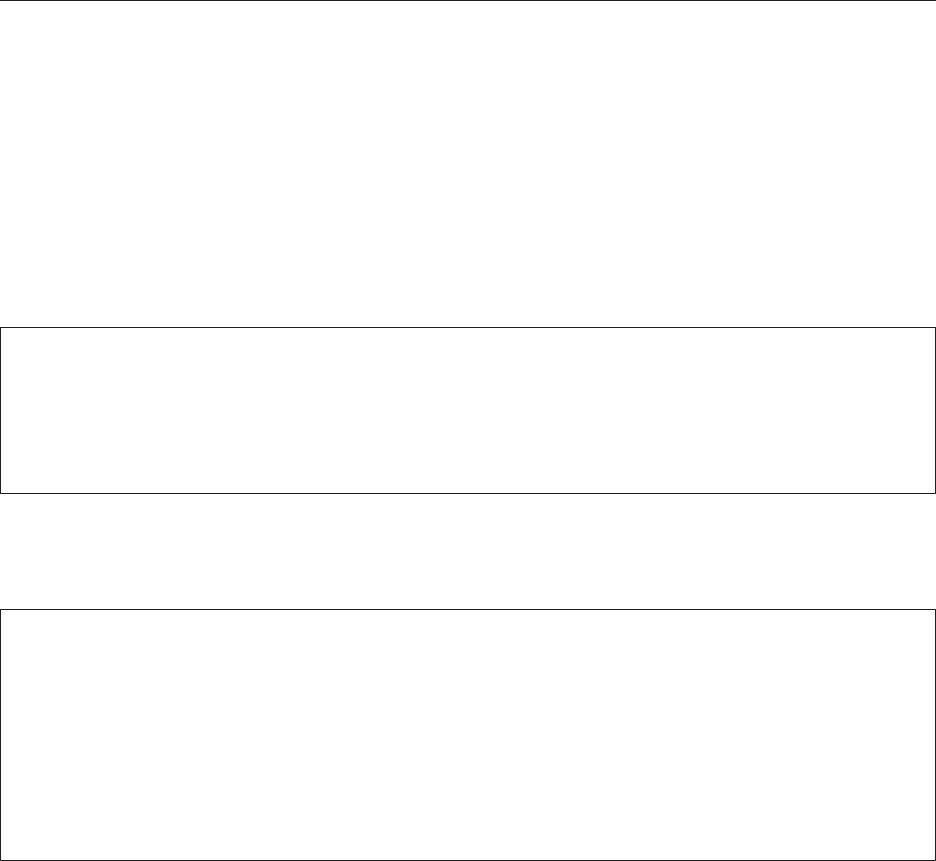
CHAPTER 7: USING MEDIA AS PART OF CLINICAL VIGNETTES 53
SELECTING MEDIA
In multiple-choice examinations, media should be purposefully selected to help the student answer the question and
not included without a good reason; otherwise, it is simply extraneous information. Do not describe with text that
which can be easily demonstrated in the media itself. In the example below, three similar items are shown with dier-
ing lead-ins and media; no graphics (Example A), a graphic depicting heart rhythms or sounds (Example B), and an
avatar simulating placement of the stethoscope (Example C). Other possibilities include showing both the ECG and
the avatar, or presenting the audio le of the corresponding heart sounds with or without a live patient video.
Consider the following stem for a cardiology multiple-choice question:
A 27-year-old Gulf War veteran with no documented medical history comes to the office because of periodic dizziness,
palpitations, and chest tightness over the past 3 weeks. The episodes occur when he remembers “the roadside bomb
that took my friend.” He has had difficulty sleeping and drinks 1 pint of vodka daily to help with “nerves.” He takes no
medications. His blood pressure is 128/80 mmHg, pulse is 90/min, respirations are 20/min, and temperature is 36.7°C
(98.1°F).
Below are three possible lead-ins and media selections for the above stem.
Example A (no image)
Which of the following is the most likely finding on cardiac auscultation of this patient with post-traumatic stress
disorder?
A. Normal examination*
B. Opening systolic snap
C. S4 gallop
D. S3 gallop
E. Systolic flow murmur
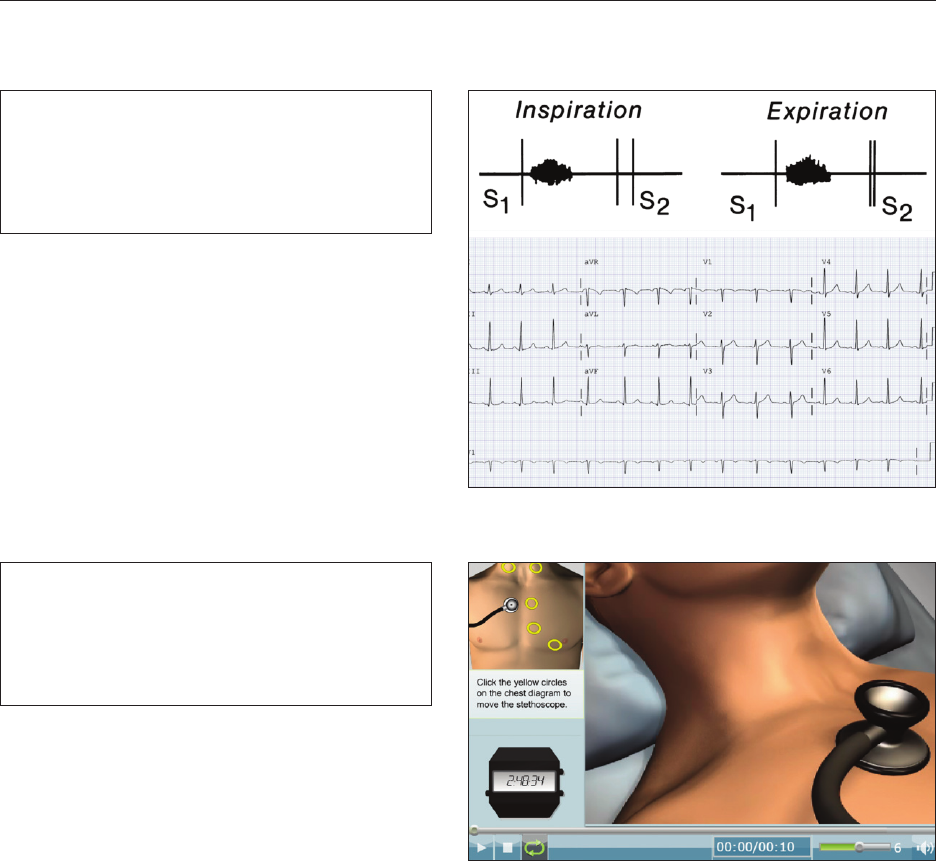
CHAPTER 7: USING MEDIA AS PART OF CLINICAL VIGNETTES54
Example B (with ECG image)
Example C (with avatar that allows auscultation of actual heart sounds through headphones)
An ECG is shown. Which of the following is the
most likely finding on cardiac auscultation? (same
options as above)
An avatar is shown. Click the yellow circles to hear
the cardiac examination. Which of the following is
the most likely finding on cardiac auscultation?
(same options as above)

CHAPTER 7: USING MEDIA AS PART OF CLINICAL VIGNETTES 55
CONTENT AREAS CONDUCIVE TO THE USE OF MEDIA
Certain content areas lend themselves well to the use of media, such as:
• Dermatologic and musculoskeletal examination ndings
• Cardiology (such as heart sounds)
• Neurologic examination ndings
• Ethical and communication scenarios
Examples of two of these areas follow.
Dermatologic and Musculoskeletal Examination ndings
Dermatologic and musculoskeletal examination ndings in particular benet from the use of media. Showing nd-
ings, rather than describing the ndings with text, simulates real clinical practice. Further, research has shown that
response time is faster with the use of media compared with text for dermatologic ndings. Consider the two fol-
lowing examples.
Example item using text
A 79-year-old woman comes to the office 8 weeks after noticing a nontender nodule on the back of her left hand. She
initially thought it was an insect bite but it has grown in size over the past week. It bleeds when she picks at it. She
has no history of serious illness. She lives in a retirement community in Texas and is an avid gardener. Examination of
the dorsum of the left hand shows a 2-cm lesion that is well-demarcated, raised, and flesh-colored at the margins, with
a necrotic center. Which of the following is the most appropriate next step in management?
A. Cryotherapy
B. Electrocautery ablation
C. Excision of the lesion*
D. Observation
E. Topical ketoconazole
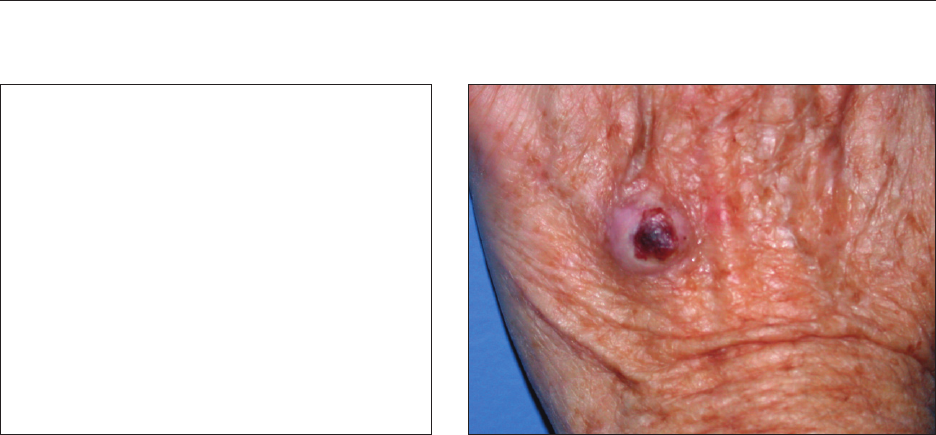
CHAPTER 7: USING MEDIA AS PART OF CLINICAL VIGNETTES56
Example item using multimedia
Ethical and Communication Scenarios
Text-based multiple-choice questions related to ethical and communication scenarios tend to be easy for the student
to answer because intonation and body language cannot be demonstrated well through text. Consider the next two
examples.
A 79-year-old woman comes to the office 8 weeks
after noticing a nontender nodule on the back of her
left hand. She initially thought it was an insect bite
but it has grown in size over the past week. It bleeds
when she picks at it. She has no history of serious ill-
ness. She lives in a retirement community in Texas and
is an avid gardener. Examination of the dorsum of the
left hand shows a 2-cm lesion. A photograph of the
lesion is shown. Which of the following is the most
appropriate next step in management? (Same op-
tions as the preceeding example)

CHAPTER 7: USING MEDIA AS PART OF CLINICAL VIGNETTES 57
Example item using text
An 83-year-old woman is hospitalized for pneumonia and renal failure. She has a history of dementia and resides in a
nursing home. She has been offered but has refused dialysis. The patient has not designated a durable power of attor-
ney, but she does have an advance directive that states,“No CPR, no intubation, no dialysis, and no surgery.” The pa-
tient’s niece, who is her closest relative, has a discussion with the physician about her aunt’s refusal of treatment. She
states, “Dialysis isn’t aggressive, right? I have a neighbor who has been getting dialysis for 5 to 6 years! I want my
aunt to get dialysis.” Which of the following is the most appropriate physician response to the niece?
A. "I can see you are upset. Would you like to speak with one of our chaplains or social workers?”
B. "I know it’s difficult, but you’re going to have to accept that your aunt will not be getting dialysis or
any other aggressive treatment. We would be breaking the law to treat her against her wishes.”
C. "I understand how you feel. Last year, I had a dear friend who died of cancer. It can be so hard to
watch and not do anything.”
D. "I’m so sorry we can’t do what you want. Let’s discuss what we can do to make sure your aunt is
comfortable."*
E. "You do not need to worry; even though we can’t do dialysis, we will try to make sure your aunt
doesn’t suffer. Do you have anyone to turn to for support right now?"

CHAPTER 7: USING MEDIA AS PART OF CLINICAL VIGNETTES58
Example item using multimedia (screen shot of an approximately 30-second interaction)
ACQUIRING AND CREATING MEDIA
When determining new media needs, a subject matter expert group can be helpful as part of the process to oversee
and monitor the acquisition process. is group can develop a list of diseases, conditions, and/or physician tasks and
skills that are best illustrated with media. Once media are acquired, this group can develop exemplars to distribute for
item-writing assignments. A good media image is one to which multiple test items can be written; this allows for the
highest chance of the image being suitable for the exam and helps address the issue of memorability. It can also oset
the cost of acquiring media.
When acquiring media, two important considerations are patient condentiality and the metadata (the information
that accompanies and identies each media image). If actual patient images or videos are used, it is important to
maintain patient condentiality. Ensure that neither the patient nor the institution can be identied from any clues in
the media. For guidance, refer to your institution’s patient condentiality policy and HIPAA guidelines
(http://www.hhs.gov/hipaa/for-professionals/index.html).
An 83-year-old woman is hospitalized for pneumonia
and renal failure. She has a history of dementia and
resides in a nursing home. She has been offered but
has refused dialysis. The patient has not designated a
durable power of attorney, but she does have an ad-
vance directive that states,“No CPR, no intubation, no
dialysis, and no surgery.” The patient’s niece, who is
her closest relative, has a discussion with the physi-
cian about her aunt’s refusal of treatment. Play the
video to view the conversation. Which of the follow-
ing is the most appropriate physician response to
the niece? (Same options as the preceeding example)

CHAPTER 7: USING MEDIA AS PART OF CLINICAL VIGNETTES 59
Metadata is the identifying information that accompanies each piece of media. It is important to obtain as much
metadata as possible about the media to help with indexing/searching and reuse in the future. ink about search
terms and metadata that will help with identication of images that will be used more than once. It is advisable to set
standards for media and copyright of media and to use a form to record as much metadata as possible during the ac-
quisition stage. e following is a sample list of information to collect and record for video material:
Search Terms/Metadata
• Administrative details
• Age of the patient
• Diagnosis
•Keywords
• Description of the test being performed
• Normal or abnormal results
• Descriptive le name
• Patient ID/Name
• Indication patient signed a consent form
• In/out cut points for individual clips
• Whether the clip contains important audio
Remember: Your media are only as good as their metadata! Media have little value in item writing if they cannot
be retrieved easily in search results.
ere are several locations from which to acquire media. e subject matter or content experts’ personal libraries
and/or patients are oen a ready option, but the issues of patient condentiality and memorability should be ad-
dressed. Furthermore, this is limited by the available patient population (item writers may not have access to a pa-
tient with the symptoms that are best to show). A second option is to purchase existing media from vendors. is is
the more expensive option, but it oen allows the test developer to request specic content areas and types of media,
along with specic instructions that will help decrease memorability. A third option is to create new media, either in-
house or with a vendor. One example would be to record a specic set of videos for use in test items related to com-
munication skills, using actors to portray both physicians and patients.
When collecting media, there are some rules of thumb to help avoid technical issues. Select a specic format that will
work with your exam soware, and verify that the media are in that format. Converting or editing les can be prob-
lematic, so it is better to have media created in the format you need rather than to have to convert a format. For static
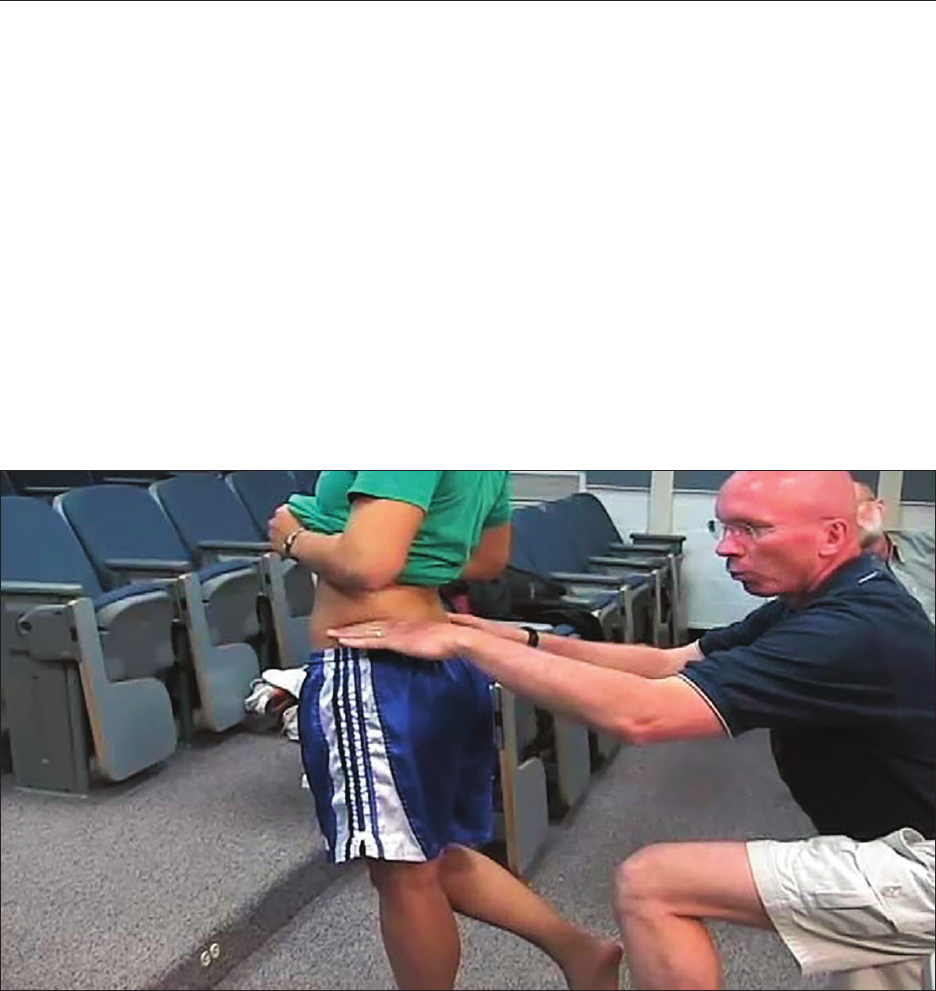
CHAPTER 7: USING MEDIA AS PART OF CLINICAL VIGNETTES60
images, do not use media that is already embedded in other soware (e.g., Microso PowerPoint, Microso Word) or
screenshots. e more an image or video is manipulated, the more chance it has of losing its original quality; ideally
media in an exam should be as high quality as possible.
With any media, the creation process should focus on protecting patient condentiality (if real patients are used) and
minimizing distractions for test-takers. A distraction is a specic type of cue that may remove the test-taker’s focus
from the important aspect of the video (e.g., busy background, clothing with logos) and increase the time it takes for
them to respond to the items, resulting in a more dicult item than intended. Distractions can also add to the mem-
orability of the item. Even professional media content vendors are unlikely to be savvy about test development or to
understand the impact that novelties and distractions can have on test-taker performance. e item writer and test
developer should provide guidelines to help media content providers develop and provide videos that maintain pa-
tients’ anonymity and minimize distractions.
Review the screenshot below taken from a video. List the things in the image that provide visual cues (distractions)
for test-takers [hint: there are 12 visual cues in the image].

CHAPTER 7: USING MEDIA AS PART OF CLINICAL VIGNETTES 61
e following are the visual cues (e.g., distractions) to the test-taker:
1. Setting (auditorium; could aid with memorability)
2. Socket is specically identiable within the auditorium (could aid with memorability)
3. Clothes in the aisle
4. Patient’s watch
5. Green shirt
6. Doctor’s ring
7. Blue and white striped shorts
8. Doctor’s watch
9. Doctor’s face/expression
10. Doctor’s shirt (white coat is preferable)
11. Doctor wearing shorts
12. Bearded man in the background (mysterious; could aid with memorability)
TIPS FOR CREATING VIDEOS
DO:
• Use a plain background
• Avoid visual cues (e.g., oce equipment, paintings)
• Record in a well-lit room
• Have the patient wear plain clothes or a hospital gown with no logos
• Keep background and clothing consistent if there are multiple patients or exams
• Have the provider talk to the patient as they would in a normal exam
• Have the provider avoid using names when addressing the patient
• Leave the videos as you record them and provide instructions for editing
• Limit the video length to 30 seconds
• Provide a signed patient consent form

CHAPTER 7: USING MEDIA AS PART OF CLINICAL VIGNETTES62
DON’T:
• Pick a brightly colored room, a room with identiable pictures on the wall, or a room with unique
(non-clinical) furniture
• Allow the patient or provider to wear brightly colored clothes, clothes with logos, or jewelry
• Show the faces of the provider(s) or patient(s) if it is not essential
• Explain everything in detail or add narration
• Add transitions (e.g., fade-in, fade-out) to video les
• Resize or change the dimensions of the video

Resources and Additional
Reading on Item and Test
Development

65
Case SM. Assessment of truths we hold as self-evident and their implications. In: Scherpbier AJJA, van der Vleuten
CPM, Rethans JJ, van der Steeg AFW, eds. Advances in Medical Education. Dordrecht, e Netherlands: Kluwer Aca-
demic Publishers; 1997:2-6.
Gronlund NE, Linn, RL. Measurement and Evaluation in Teaching. 6th ed. New York, NY: Macmillan Publishers; 1990.
Haladyna TM. Writing Test Items to Evaluate Higher-Order inking. Needham Heights, MA: Allyn & Bacon; 1997.
Haladyna TM, Downing SM. A taxonomy of multiple-choice item-writing rules. Applied Measurement in Education.
1989a;1:37-50.
Haladyna TM, Downing SM. e validity of a taxonomy of multiple-choice item-writing rules. Applied Measurement
in Education. 1989b;1:51-78.
Haladyna TM, Downing SM, Rodriguez MC. A review of multiple-choice item-writing guidelines for classroom
assessment. Applied Measurement in Education. 2002;15(3):309-333.
Haladyna TM, Rodriguez MC. Developing and Validating Test Items. New York, NY: Routledge; 2013.
Henrysson S. Gathering, analyzing, and using data on test items. In: orndike RL, ed. Educational Measurement.
Washington, DC: American Council on Education; 1971.
Hubbard JP. Measuring Medical Education. Philadelphia, PA: Lea & Febiger; 1971.
Hubbard JP, Clemens WV. Multiple-Choice Examinations in Medicine. Philadelphia, PA: Lea & Febiger; 1961.
Kelley TL. e selection of upper and lower groups for the validation of test items. Journal of Educational Psychology.
1939;30:17-24.
Resources and Additional Reading on Item
and Test Development

RESOURCES AND ADDITIONAL READING ON ITEM AND TEST DEVELOPMENT66
Linn RL, Gronlund NE. Measurement and Assessment in Teaching. 7th ed. New York, NY: Macmillan Publishers;
1995.
Millman J, Greene J. e specication and development of tests of achievement and ability. In: Linn RL, ed. Educa-
tional Measurement. 3rd ed. Phoenix, AZ: Oryx Press; 1989:335-366.
Newble DI, Dauphinee D, Woolliscro JO, et al. Guidelines for assessing clinical competence. Teaching and Learning
in Medicine. 1994;6(3):213-220.
Norman G, Swanson DB, Case SM. Conceptual and methodological issues in studies comparing assessment formats.
Teaching and Learning in Medicine. 1996;8(4):208-216.
Osterlind SJ. Constructing Test Items: Multiple-choice, Constructed-response, Performance, and Other Formats. Nor-
well, MA: Kluwer Academic Publishers; 1998.
Parshall CG, Harmes JC, Davey T, Pashley PJ. Innovative items for computerized testing. In: Elements of Adaptive
Testing. New York, NY: Springer; 2009:215-230.
Rodriguez, MC. Selected-response item development. In: Lane S, Raymond MR, Haladyna TM, eds. Test Develop-
ment. 2nd ed. New York, NY: Routledge; 2015:259-273.
Shen L, Li F, Wattleworth R, Filipetto F. e promise and challenge of including multimedia items in medical licen-
sure examinations: some insights from an empirical trial. Academic Medicine. Oct 2010;85(10 suppl): S56-S59.
Swanson DB, Case SM. Assessment in basic science instruction: Directions for practice and research. Advances in
Health Sciences Education: eory & Practice. 1997;2:71-84.

Appendix A:
NBME Retired Item Formats

69
In order to move forward with innovations in assessment, it is necessary to look back on item types previously used
on NBME exams and better understand item content or format aws that can negatively impact the measurement of
test-taker ability. Multiple item types were used on NBME exams beginning in the mid-1980s in order to provide suf-
cient variety for the relatively lengthy examinations, with four predominant types: A-type, B-type, C-type, and K-
type items. e current USMLE Step examinations now include only one of these original four, the A-type item,
along with the more recently developed F-type and G-type items. Other NBME-produced exams, such as subject and
specialty board examinations, may include R-type items as well, which are newer than those mentioned above. ese
item types are summarized below:
• A-type – Standard one-best-answer item type
• R-type – Single option sets that are associated with multiple items/vignettes
• F-type – Items grouped into sets around specic content, where test-takers cannot return to previously
seen items in the set
• G-type – Items grouped into sets around specic content, where test-takers can return to previously
seen items in the set
Limiting the number of acceptable item types that appear on USMLE and other exams provides several advantages.
First, it allows item authors to spend less time thinking about item types and more time concentrating on the most
important aspects of item writing, such as clinical decision-making to test reasoning and problem-solving rather than
recall. Second, it reinforces the standardized nature of the items within test forms, thus simplifying the process for
test-takers and supporting the validity evidence of the exams. ird, it allows for more ecient production, editing,
and approval of items.
Examples of retired item types and their aws are described on the following pages, in alphabetic order by the letter
used to designate item type. Please note that while these item types are no longer used on NBME exams, they may
still be of potential use in the classroom or on course exams, but item writers should carefully review the potential
aws in order to properly evaluate the advantages and disadvantages of using each item type.
Appendix A: NBME Retired Item Formats

APPENDIX A: NBME RETIRED ITEM FORMATS70
B-Type Items
Noted Flaws:
B-type items are matching sets that were assumed to widen the scope of the examination by testing a number of re-
lated subjects in a series of items. Because each response could be used more than once or not at all, B-type items
could not be solved by elimination. Unlike the matching formats used today, B-type items did not typically include a
lead-in, and as a result, the question being asked was sometimes unclear.
Sample B-type item
DIRECTIONS: Each set of matching questions in this section consists of a list of three to five lettered options (some of
which may be in figures), followed by several numbered items. For each numbered item, select the ONE lettered option
that is most closely associated with it. Each lettered option may be selected once, more than once, or not at all.
A. Aortic vascular ring
B. Coarctation of the aorta
C. Patent ductus arteriosus
D. Tetralogy of Fallot
E. Tricuspid atresia
1. Benefited by systemic-pulmonary artery anastomosis
2. Hypertension in the arms and hypotension in the legs
3. Most common type of congenital cyanotic heart disease
4. Possible cause of dysphagia in infants and children
5. Surgically corrected by resection and end-to-end anastomosis

APPENDIX A: NBME RETIRED ITEM FORMATS 71
C-Type Items
Noted Flaws:
C-type items are similar to B-type items in appearance, but are actually multiple true-false. e primary problem
with C-types was in test-taker eort to conclude to what extent something had to be “true” to be selected. Using the
example below, if one of the numbered options was associated with both A and B, but was more strongly associated
with A, the test-taker would have to decide whether an appropriate response was A only or both A and B. ese judg-
ments were less about the medical knowledge and more about the test-taker having to guess the item writer’s intent.
Sample C-type item
DIRECTIONS: Each set of matching questions in this section consists of a list of four lettered options followed by sev-
eral numbered items. For each numbered item, select the ONE lettered option that is most closely associated with it.
Each lettered option may be selected once, more than once, or not at all.
A. Plasmodium vivax malaria
B. Plasmodium falciparum malaria
C. Both
D. Neither
1. A combination of primaquine and chloroquine is treatment of choice for acute attack
2. Clinical attacks suppressed by administration of chloroquine once a week while in treatment
3. Infection prevented by administration of chloroquine once a week
4. Permanently cured by administration of chloroquine

APPENDIX A: NBME RETIRED ITEM FORMATS72
D-Type Items
Noted Flaws:
D-type items are complex matching sets in which each item consists of three functional disturbances (designated by a
letter) and ve situations (in a numbered list). It was believed that these items required discriminatory understanding
of a number of similar factors. However, D-type items were dicult to write, and the directions tended to be confus-
ing to test-takers. In addition, these items did a poor job of discriminating among test-takers’ level of knowledge.
Sample D-type item
DIRECTIONS: There are two responses to be made to each of the following questions. There are three lettered cate-
gories. Exactly four of the five numbered items are related in some way to ONE of these categories. (1) Choose the let-
ter of the category in which these four items belong. (2) Then choose the number of the item that does NOT belong in
the same category with the other four.
A. Eosinophilia of diagnostic significance
B. Lymphocytosis of diagnostic significance
C. Plasmacytosis of diagnostic significance
1. Hodgkin disease
2. Löeffler syndrome
3. Multiple myeloma
4. Schistosomiasis
5. Trichinosis

APPENDIX A: NBME RETIRED ITEM FORMATS 73
H-Type Items
Noted Flaws:
H-type items consist of paired statements describing two entities to compare in a quantitative sense. e test-taker
was directed to select A if A was greater than B; B if B was greater than A; and C if the two were approximately equal.
e H-type item was believed to be useful for those instances where recall of quantitative information is important,
but it was challenging for test-takers to decide how great the dierence needed to be in order to be relevant.
Sample H-type item
DIRECTIONS: The following paired statements describe two entities that are to be compared in a quantitative sense.
For each numbered statement, choose
A if (A) is greater than (B)
B if (B) is greater than (A)
C if the two are equal or very nearly equal
1. (A) The usual therapeutic dose of epinephrine
(B) The usual therapeutic dose of ephedrine
2. (A) Life expectancy with glioblastoma of the occipital lobe
(B) Life expectancy with glioblastoma of the frontal lobe

APPENDIX A: NBME RETIRED ITEM FORMATS74
I-Type Items
Noted Flaws:
e I-type item is similar to the H-type. It consists of pairs of phrases that describe conditions or quantities that
might vary in relation to each other. I-type items had two notable aws. First, there were fewer options than in other
item types, so there was an increased chance for the test-taker to guess the correct answer, which aected both item
diculty and discrimination. Second, the items tended to focus on minor details rather than on more relevant scien-
tic concepts.
Sample I-type item
DIRECTIONS: Each of the following pairs of phrases describes conditions or quantities that may or may not be related.
For each numbered statement, choose
A if increase in the first is accompanied by increase in the second or if decrease in the first is
accompanied by decrease in the second
B if increase in the first is accompanied by decrease in the second or if decrease in the first is
accompanied by increase in the second
C if changes in the first are not necessarily accompanied by changes in the second
1. (A) Urine volume
(B) Urine specific gravity
2. (A) Plasma protein concentration
(B) Colloid osmotic pressure of plasma

APPENDIX A: NBME RETIRED ITEM FORMATS 75
K-Type Items
Noted Flaws:
K-type items are multiple true-false sets that were once a common format at NBME. Because the items could include
only absolutely true or false facts, K-type items could not be used to assess clinical judgment except in comparisons
(e.g., “Drug X is better than Drug Y in treating disease K”). us, they could appear too complicated and require the
test-taker to constantly keep the answer code in mind. In addition, the possible response combinations introduced a
cueing eect that decreased item discrimination.
Sample K-type item
Directions Summarized
ABCDE
1, 2, 3 only 1, 3 only 2, 4 only 4 only All are correct
A child experiencing an acute exacerbation of rheumatic fever usually has:
1. a prolonged PR interval
2. an increased antistreptolysin O titer
3. an increased erythrocyte sedimentation rate
4. subcutaneous nodules

Appendix B:
Sample Lead-ins Based on
Provider Task Competencies

79
Medical Knowledge: Applying Foundational Science Concepts
Foundational (basic) science comprises items that require understanding and application of basic science principles
to answer the question. Foundational science items should not be answerable based simply on clinical knowledge
alone or on pattern recognition (for example, providing a list of symptoms and asking what drug to prescribe). ese
items should require clinical knowledge and also knowledge of one or more foundational science principles that
would have likely been learned in pre-clinical education and hopefully reinforced during clinical rotations.
Patient Care: Diagnosis - Causes and Mechanisms
Identies the cause/causal agent or predisposing factor(s) or, given an eect, determines the cause.
• Which of the following pathogens is the most likely cause of this patient’s condition?
• Which of the following is the most likely causal agent?
• is patient most likely acquired the causal organism via which of the following modes of transmission?
• is patient most likely has a defect in which of the following?
• Which of the following is the most likely cause/mechanism of this eect?
Identies the underlying processes/pathways that account for, or contribute to, the expression or resolution of a given
condition.
• Which of the following is the most likely underlying cause of this patient’s condition?
• Which of the following is the most likely explanation for this patient’s condition?
• Which of the following cell types most likely played a primary role in the development of this lesion?
• Which of the following immune system mediators plays a critical role in the pathogenesis of this patient’s
current condition?
• is patient most likely has a deciency in which of the following enzymes?
• Which of the following cytokines is the most likely cause of this condition?
• Which of the following processes is most likely impaired in this patient?
Appendix B: Sample Lead-ins Based on Provider
Task Competencies

APPENDIX B: SAMPLE LEAD-INS BASED ON PROVIDER TASK COMPETENCIES80
Recognizes or evaluates given clinical or physical ndings to identify the underlying anatomic structure or physical
location.
• e most likely cause of the ndings in this patient is damage to which of the following structures?
• Which of the following structures is at greatest risk for damage during this procedure?
• Which of the following nerves is most likely carrying the sensation for this patient’s pain?
• e most likely cause of these ndings is dysfunction of which of the following structures?
• Which of the following developmental abnormalities is the most likely cause of the ndings in this patient?
Recognizes the mechanisms of action of various drugs; selects from an option set list of drugs based on mechanism
of action.
• Which of the following is the most likely mechanism of the benecial eect of this drug?
• Which of the following is the most appropriate management? (response options would be drug classes
or mechanisms of action)
• Which of the following is the most likely mechanism of action of the therapeutic eect of this drug?
• e most appropriate medication for this patient will have which of the following mechanisms?
Patient Care: Diagnosis - Obtaining and Predicting History and Physical Examination
Knows signs/symptoms of selected disorders. Response options are signs and symptoms. e item asks which signs
and symptoms are characteristic of the patient's condition. Typically used when patient presents with the condition.
• Which of the following signs/symptoms is most consistent with the underlying diagnosis in this patient?
Knows individual's risk factors for development of condition. Given current symptoms in presented history, identies
pertinent factor in the history. Typically used when patient presents with the condition.
• Which of the following factors in this patient’s history most increased the risk for developing this
condition?
Given a specic problem, knows what to ask to obtain pertinent additional history. e response options should not
be referenced in the vignette and should not include details that would be obtained during initial history-taking. If
asking about information that was already obtained and is mentioned in the vignette, use the following lead-in.
• Specic additional history should be obtained regarding which of the following?

APPENDIX B: SAMPLE LEAD-INS BASED ON PROVIDER TASK COMPETENCIES 81
Predicts the most likely additional physical nding; selects either the nding itself or the appropriate examination
technique that would result in the nding. e options are ndings or directed physical examination techniques.
• e remainder of the physical examination is most likely to show which of the following? (ensure all options
are portions of the physical examination that would not yet have occurred in the patient scenario)
• e physical examination should be directed toward which of the following? (sample options: “Auscultation
of the lungs”, “Palpation of the abdomen”, “Rotation of hip joints”)
• Which of the following signs or symptoms is most indicative of the need for further studies?
Patient Care: Diagnosis - Selecting and Interpreting Laboratory and Diagnostic Studies
Selects most appropriate laboratory or diagnostic study, including neuropsychiatric testing, or study most likely to es-
tablish/conrm the diagnosis. Options can include “no further testing is indicated.”
• Which of the following is the most appropriate diagnostic study at this time?
• Which of the following is the most appropriate initial diagnostic study?
• Which of the following is the most appropriate next step in evaluation?
• Which of the following studies is most likely to establish a diagnosis?
• Which of the following laboratory studies is most likely to conrm the diagnosis?
• Which of the follow-up studies is most appropriate to order?
• Which of the following studies should be obtained periodically to monitor the patient’s long-term care?
Interprets laboratory or other study ndings. Response options are interpretations of the laboratory/diagnostic data.
• Which of the following is the most likely explanation for these laboratory ndings?
• Based on these ndings, this patient's condition is most likely attributable to which of the following?
Predicts the most likely laboratory or diagnostic study result. Response options are clinical studies or predicted study
results.
• Results of which of the following laboratory studies are most likely to be abnormal in this patient?
• Measurement of serum electrolyte concentrations is most likely to show which of the following?
• An x-ray of the _________ is most likely to show which of the following?
• Arterial blood gas analysis is most likely to show which of the following sets of ndings?
Selects most appropriate laboratory or diagnostic study aer change in patient status.
• Prior to changing this patient’s therapy, which of the following is the most appropriate diagnostic study?

APPENDIX B: SAMPLE LEAD-INS BASED ON PROVIDER TASK COMPETENCIES82
Patient Care: Diagnosis - Formulating the Diagnosis
Selects the most likely diagnosis.
• Which of the following is the most likely diagnosis?
• Which of the following is the most likely working diagnosis?
• Which of the following best explains these ndings? (options would be diagnoses); correct answer could be
“Normal nding(s)”.
• Which of the following organisms is the most likely cause of this patient’s pneumonia?
Patient Care: Diagnosis - Determining Prognosis/Outcome
Recognizes factors in the history, or physical or laboratory study ndings that aect patient prognosis or outcome, or
that determine therapy.
• Which of the following factors in this patient's history most strongly indicates a poor/good prognosis?
• Which of the following factors is most critical in determining the patient’s ability to remain at home?
Interprets laboratory or other diagnostic study results and identies current/future status of patient.
• Based on these ndings, this patient is most likely to develop which of the following?
• Based on these ndings, this patient is most likely to develop which of the following during ______ (period
of time)?
Recognizes associated conditions of a disease, including complications, or indicators of potential complications.
• Which of the following is the most likely complication of this patient’s current condition?
• Without treatment, which of the following is most likely to develop in this patient?
Recognizes characteristics of disease relating to natural history or course of disease, including progression, severity,
duration, and transmission of disease for a specic patient.
• Which of the following is the most likely clinical course for this patient?
• is patient should be informed of which of the following risk factors?

APPENDIX B: SAMPLE LEAD-INS BASED ON PROVIDER TASK COMPETENCIES 83
Patient Care: Management - Health Maintenance & Disease Prevention
Knows risk factors for conditions amenable to prevention or detection in an asymptomatic patient or knows the po-
tential condition itself.
• Which of the following is the strongest predisposing factor in this patient for developing a chronic condition?
• is patient should be counseled that he/she is at greatest risk for which of the following?
• If untreated, this patient is at greatest risk for which of the following disorders?
Knows pertinent incidence statistics and identies patient groups at risk; knows incidence of symptomless/dangerous
disorders among various groups. Response options compare patient's risk factors for disease with those of the general
population.
• Which of the following factors is most appropriate to consider in assessing the need for additional screening
in this patient population?
Knows common screening tests for conditions amenable to prevention or detection in an asymptomatic patient or
population.
• In addition to a (screening test) annually, which of the following screening studies is most appropriate?
• Which of the following is the most appropriate screening test for this patient at this time?
• At this time, which of the following is the most appropriate next step in the evaluation of this patient?
(response options would be screening tests)
Selects appropriate preventive agent or technique (e.g., contraception, vaccines, vitamins). Knows timing of vaccina-
tions.
• Which of the following is the most appropriate recommendation for vaccination?
• [To reduce the likelihood of recurrence,] it is most appropriate to (prescribe/administer) which of the following?
• Which of the following is the most appropriate vaccine to administer at this time?
Knows appropriate counseling (and reassuring, comforting) of patient or family regarding current and future prob-
lems, including risk factors related to present encounter. e response options focus on features and course of disease
as they relate to a specic patient.
• is patient should be counseled regarding which of the following?
• Which of the following is the most appropriate management to prevent the spread of this patient’s illness?

APPENDIX B: SAMPLE LEAD-INS BASED ON PROVIDER TASK COMPETENCIES84
Educates patients on screening, health maintenance, and self-care options such as nutrition, weight loss, breast self-
examinations, home blood pressure monitoring, or breast-feeding. e response options are a variety of patient ac-
tions.
• Which of the following is the most appropriate recommendation?
• is patient should be advised to do which of the following?
Patient Care: Management - Selecting and Monitoring Pharmacotherapy
Selects most appropriate pharmacotherapy. Response options are all drugs or “No pharmacotherapy at this time.”
Drugs include substances such as vitamins and supplements.
• Which of the following is the most appropriate pharmacotherapy at this time?
• e most appropriate next step is to administer which of the following?
Assesses patient adherence to treatment regimen, recognizes techniques to increase compliance with or understand-
ing of the disease state, and knows how adherence may be aected by providing instructions with therapy. Options
can include “No further testing is indicated.”
• To assess adherence and therapeutic ecacy in this patient, which of the following studies should be ordered
aer initiation of therapy?
• Which of the following methods is most appropriate to assess adherence to treatment in this patient?
Recognizes factors that alter drug requirements for a patient, such as disease, age, pregnancy, BMI, renal failure, liver
disease, or female gender. Response options are factors about the patient that aect the choice of a drug regimen.
• Which of the following variables is most appropriate to consider in determining the appropriate dose
of medication for this patient?
• Which of the following factors is most likely to inuence therapy for this patient?
• Which of the following is most appropriate to consider before selecting pharmacotherapy?
Knows adverse eects of various drugs or recognizes signs and symptoms of drug (and drug-drug) interactions re-
sulting from polypharmacy in the therapeutic regimen, and knows steps to prevent polypharmacy including labora-
tory studies to monitor drug therapy. Vignette includes description of the simultaneous use of drugs prescribed by
another physician, over-the-counter drugs, prescribed opioids and other Schedule IV medications taken illegally or
in greater than prescribed doses, illegal opioids, alcohol, and certain foods.

APPENDIX B: SAMPLE LEAD-INS BASED ON PROVIDER TASK COMPETENCIES 85
• Which of the following is the most likely cause of this patient’s symptoms?
• Which of the following is the most likely complication of the addition of this medication?
• Which of the following is the most likely explanation for this patient’s current condition?
• e most likely cause of this patient’s condition is interaction between which of the following drugs?
Knows contraindications of various medications.
• Which of the following medications is contraindicated in this patient?
• Which of the following medications is most likely to increase the risk for development/progression of
__________ (diagnosis) in this patient?
Knows modications of a therapeutic regimen within the context of continuing care.
• Which of the following is the most appropriate next step in pharmacotherapy?
• Which of the following is the most appropriate change/modication in this patient’s drug therapy?
Knows appropriate monitoring to evaluate eectiveness of drug therapy or to monitor for the adverse eects of drug
therapy in a patient who has not had a recurrence or progression of disease.
• Which of the following studies is most appropriate to monitor the eectiveness of therapy in this patient?
Patient Care: Management - Clinical Interventions/Treatment
Knows most appropriate management of selected conditions, including recognizing use/misuse of medications, illicit
drugs, or alcohol. Response options would be a list of management steps.
• Which of the following is the most appropriate next step in management?
• Which of the following is the most appropriate initial management/recommendation?
Knows immediate management or priority in management, specically in emergency or acute cases. is objective is
most appropriate in life-threatening emergencies or cases of potential organ failure.
• Which of the following is the most appropriate immediate/initial/next step in management?
• Which of the following is the priority in management?
• Which of the following is the most critical factor in formulating a management plan for this patient?
Knows most appropriate follow-up or monitoring approach regarding the management plan.
• Which of the following is the most appropriate monitoring/follow-up plan?

APPENDIX B: SAMPLE LEAD-INS BASED ON PROVIDER TASK COMPETENCIES86
Knows current/short-term management of patients.
• Which of the following is the most appropriate next step following treatment?
• Which of the following is the most appropriate next step in monitoring this patient?
Evaluates severity of patient condition in terms of need for referral for surgical treatments/procedures versus other
nonsurgical options.
• Which of the following ndings in this patient indicates the need for surgical intervention/intubation/
transplantation/admission to another department?
Knows appropriate surgical management. e response options are all surgical procedures.
• Which of the following is the most appropriate surgical management?
Knows pre/post surgical or procedural management.
• Which of the following is the most appropriate postoperative management?
• Which of the following is the most appropriate preoperative preparation?
• Prior to the procedure (or specify the procedure), it is appropriate to rst obtain/do which of the following?
Knows indications for admission to the hospital or to other appropriate setting. Knows appropriate nonhospital
health care settings, such as a nursing care facility, hospice care, or at-home care with assistance of health aide.
• Placement in a/an ___________ is recommended based on which of the following factors?
• is patient should be transferred to which of the following inpatient facilities?
Knows most appropriate discharge planning.
• In discussing discharge plans with this patient, it is most appropriate to advise him/her of which
of the following?
• Before this patient is discharged, he/she should be counseled regarding which of the following?
• Which of the following is the most appropriate goal for follow-up?
Knows components of rehabilitation program, such as prostheses, psychosocial factors, or motor dysfunction. e re-
sponse options are rehabilitation management steps.
• Which of the following components of his/her overall care is most appropriate to consider?

APPENDIX B: SAMPLE LEAD-INS BASED ON PROVIDER TASK COMPETENCIES 87
Knows appropriate use and procedures regarding hospice care.
• Which of the following is the most appropriate step regarding hospice care for this patient?
• Which of the following is the most appropriate next step? (hospice referral is correct answer).
Educates patient or family regarding self-care, such as breast-feeding, or at-home blood pressure measurement and
glucose monitoring. e response options can be a variety of patient actions.
• Which of the following is the most appropriate recommendation?
• is patient should be advised to do which of the following?
Knows relevant roles of allied health personnel.
• e most appropriate next step is to arrange consultation with which of the following?
• is patient should be referred to which of the following?
Patient Care: Management - Selecting Clinical Interventions (Mixed Management)
Selects most appropriate option from set of mixed management options (e.g., mix of diagnostic studies, pharma-
cotherapy, procedures, or no intervention at this time, observation, referral).
• Which of the following is the most appropriate next step?
• Which of the following is the most appropriate initial step in management?
Patient Care: Management - Monitoring/Surveillance for Disease Recurrence or Progression
Knows the indications for surveillance for recurrence or progression of disease following treatment.
• Which of the following is the most appropriate annual monitoring study?
Knows how to monitor a chronic disease in a stable patient where a change in patient status might indicate a need to
change therapy.
• Which of the following is the most appropriate diagnostic study at this time?
Knows most appropriate long-term treatment or management goals, including continued treatment of a known pa-
tient. In a patient with a chronic condition, knows preventive medicine.
• Which of the following is the most appropriate long-term management?
• is patient should be advised of which of the following long-term management goals?

APPENDIX B: SAMPLE LEAD-INS BASED ON PROVIDER TASK COMPETENCIES88
Communication and Interpersonal Skills
• Which of the following is the most appropriate opening remark to this patient?
• Which of the following is the most appropriate response by the physician?
• Which of the following statements by the physician is most appropriate to...?
Professionalism and Legal/Ethical Issues
Knows the guidelines for obtaining informed consent for treatment including those for children and adolescents,
third-party permission, and emergent situations.
• Which of the following is the most appropriate method to facilitate patient informed consent?
Recognizes need for third-party permission for treatment in medical emergencies.
• In requesting an autopsy, consent must be given by which of the following individuals?
Knows guidelines for treatment of minors with/without notication of parents.
• Regarding obtaining consent for treatment today, which of the following is the most accurate conclusion
for providing services to this patient?
• Until the parents can be reached, management should consist of which of the following?
• Before examining this patient, informed consent needs to be obtained from which of the following individuals?
• Which of the following is the most appropriate response to the request for services for this child/adolescent?
Knows denitions of competence and sanity.
• Determination of this patient’s competency to make decisions should be based on which of the following factors?
• Which of the following is the most signicant indication that this patient may not have sucient capacity
for informed consent or refusal?
• Which of the following factors or ndings renders this patient incompetent to make health care decisions on
her/his own behalf?
• e information that is most decisive in determining this patient’s mental capacity to refuse treatment is which
of the following?

APPENDIX B: SAMPLE LEAD-INS BASED ON PROVIDER TASK COMPETENCIES 89
Knows the guidelines for involuntary admission (e.g., third-party permission, court order).
• Which of the following is the most appropriate next step? (answer is involuntary admission)
• In considering commitment of this patient to ___________, which of the following is the most appropriate
next step?
Knows guidelines for such things as condentiality of medical records (e.g., regarding patient's relatives, employer,
insurance/legal agents), boundaries, privacy, and truth-telling.
• Which of the following is the most accurate statement concerning the condentiality of this patient’s medical
record?
Knows guidelines for physician/patient relationship.
• Regarding this colleague’s behavior, which of the following is the most appropriate advice to this patient?
Assesses degree of disclosure to terminally ill patients.
• Which of the following is the primary consideration regarding informing this patient of his/her
condition/prognosis?
Recognizes patient's right to refuse treatment or testing (patient autonomy); knows issues of advance directives and
living wills.
• Which of the following is the most appropriate advice to the family regarding their wishes for this patient?
• Given your knowledge of this patient and her past wishes, which of the following is the most appropriate
recommendation?
• In reaching an opinion about whether do-not-resuscitate status should be ordered, which of the following
information has the highest priority?
• e best method of ensuring that this patient's wishes will be honored is to do which of the following?
Assesses quality of life decisions (especially in the elderly patient).
• In considering treatment options for this patient, which of the following is the most compelling consideration?
• Which of the following is the most appropriate next step regarding this patient’s end-of-life needs?
Knows appropriate prescriptive practices; knows appropriate use of opioids in terminally ill patients.
• Which of the following is the most eective intervention to minimize this patient’s pain?

APPENDIX B: SAMPLE LEAD-INS BASED ON PROVIDER TASK COMPETENCIES90
Knows denition of and legal issues regarding brain death.
• Which of the following is the most critical ethical consideration in deciding whether to withdraw life support
in this patient?
• Which of the following is the most accurate statement regarding the physician’s decision to discontinue
life support in this patient?
• In order for a clinical diagnosis of brain death to be made in this child, documentation of which of the
following is needed?
Knows management of terminally ill patients related to treating chronic pain, and recognizes patient's expression of
fear of pain, injury, or death; knows how to comfort patient or family during crisis such as trauma or death.
• Which of the following is most appropriate to manage this patient’s pain?
• Which of the following is the most appropriate advice for this patient regarding his/her pain?
• Which of the following is the most likely underlying cause of this change in behavior?
• In addressing this patient's (fear), which of the following is the most appropriate counseling?
Knows guidelines for reporting ndings to proper authorities, such as social services, police medical society, or coro-
ner.
• Which of the following is the most appropriate action in patient care?
Knows Good Samaritan laws.
• Regarding your colleague's liability associated with this patient’s actions at the scene of the collision, which of
the following is the most accurate conclusion?
Recognizes physician error and negligence.
• With regard to the possibility that this situation represents medical malpractice, it is most critical to do
which of the following?
• e most appropriate response to this situation is to do which of the following?
• Aer you document the error, the most appropriate management is to do which of the following?
• Which of the following is the most appropriate response to this allegation?
Recognizes and deals appropriately with impaired physicians.
• e most appropriate response to the licensing board is to recommend which of the following?
• Which of the following is the most appropriate action (where options describe dealing with impaired
colleague)?

APPENDIX B: SAMPLE LEAD-INS BASED ON PROVIDER TASK COMPETENCIES 91
Systems-based Practice and Patient Safety
Understands basic concepts and terminology, principles, and application of quality improvement science and out-
come analysis.
• Which of the following is the most appropriate description of the deviation from ocial procedure?
Recognizes and optimizes human and environmental factors such as workplace design, standardization, and
processes.
• Which of the following is the most appropriate next step in designing a standard process for...?
• Which of the following is most likely to improve patient satisfaction?
• Which of the following strategies is most likely to achieve this goal?
• Which of the following is the most appropriate next step by this hospital to improve its system of care?
• Which of the following is the most appropriate initial recommendation by the task force?
• Which of the following is most likely to improve outcomes in this situation?
• Which of the following is most likely to decrease morbidity/mortality in this situation?
Understands the role and characteristics of teams and communication strategies.
• Which of the following is most appropriate to ensure the success of this project?
• Which of the following actions is most likely to improve communication within this health care team?
Anticipates, recognizes, analyzes, and mitigates risk (sources of error).
• Which of the following is the most appropriate method to prevent/reduce the risk of transmission
of this infection?
• Which of the following is most likely to prevent recurrence of this type of error?
• Which of the following is the most likely cause of the error?
• Which of the following is most likely to decrease the likelihood of this error happening again?
• Which of the following is the most appropriate next step?
Evaluates, reports, and responds to near-misses and system errors.
• Which of the following is the most appropriate action by the hospital sta immediately following the incident?

APPENDIX B: SAMPLE LEAD-INS BASED ON PROVIDER TASK COMPETENCIES92
Practice-based Learning - Applied Biostatistics and Clinical Epidemiology
Understands and can apply principles of epidemiology and population health, including health status indicators, out-
break investigation, points of intervention.
• Which of the following is the most likely eect on estimates of disease incidence and prevalence?
• Which of the following is the annual incidence of __________ in this study?
Understands and can apply principles of study design/aws, such as bias and confounding, and methods to address
these aws; understands and can apply statistical principles.
• e most likely cause of the study results is an error related to which of the following?
• Which of the following features of this study is of greatest potential concern?
• Which of the following potential aws is most likely to invalidate this study?
• Which of the following best describes this study design?
• Which of the following is the major advantage of this study design?
Understands and can apply the principles of screening and other tests (e.g., sensitivity, specicity, predictive value).
• Which of the following is the most likely eect on sensitivity and specicity?
• Which of the following is the most likely eect on the predictive value?
• If the prevalence of the disease is increased to __%, which of the following would be the most likely outcome?
• According to these results, which of the following represents the sensitivity of _______ for detecting
_________ within this population?
• According to these results, which of the following is closest to the predictive value of a positive test result?
• If _________ were decreased to ____________, which of the following would be the most likely result?
• Changing the screening population is most likely to have which of the following eects on this test?
• In determining the appropriate diagnostic test for this patient, which of the following characteristics
of the test is most appropriate to consider?
• Which of the following is the most appropriate conclusion regarding the test?
• Which of the following combinations of sensitivity and specicity would be characteristic of the most
appropriate conrmatory/screening test?
Understands use and interpretation of statistical principles and measures of association.
• Which of the following conclusions can be drawn from these data?
• Which of the following is the most appropriate conclusion about these data?

APPENDIX B: SAMPLE LEAD-INS BASED ON PROVIDER TASK COMPETENCIES 93
• Which of the following is the most accurate interpretation of these data?
• Based on these additional data, it is most appropriate to conclude which of the following?
• Which of the following conclusions is most strongly justied based on this information/study?
• Which of the following is the most accurate interpretation of the author’s conclusion regarding these
study results?
• Which of the following is the most likely explanation for this nding?
• Which of the following represent the results of a meta-analysis?
• In determining the validity of the meta-analysis, which of the following is the most appropriate factor
to consider?
• Which of the following is the best interpretation of this condence interval? Compared with ___________,
which of the following is the relative risk for ___________ in ___________?
• Which of the following is the estimated odds ratio of __________ in _________ compared with
____________?
• Which of the following is the best estimate of the relative risk of ________________ for those with
___________ compared with those with _______________?
• Which of the following is the relative risk for _____________ 5 years following __________?
• Which of the following is the attributable (excess) risk per ________ patients for development of
______________ 5 years following _____________?
• Which of the following variables is measured on a nominal scale?
• Which of the following is the mean (or mode or standard deviation) in the sample shown in the graph?
• Assuming a normal (Gaussian) distribution, which of the following best represents the median _________ for
this group? According to these results, how many patients would need to be treated with the new drug to
prevent mortality in one patient?
• Which of the following is the number needed to treat with ____________ instead of ___________ to prevent
_________ in one patient?
• Based on these data, which of the following best represents the number of patients that must be treated with
__________ to prevent one episode of ___________?
• e outcome of this study is statistically signicant because of which of the following?
• Which of the following statistics is most likely to establish the dierence among the ________ of these groups?
• Which of the following is the case-fatality rate for ________________?
• Which of the following is the expected number of false negatives (OR false positives) in this population of
____________ women/men?

APPENDIX B: SAMPLE LEAD-INS BASED ON PROVIDER TASK COMPETENCIES94
• Which of the following best explains the lack of a signicant dierence in ________________?
• Which of the following is the likelihood of survival?
Makes decisions about patient care based on results of studies or other written materials (e.g., pharmaceutical
advertisements, abstracts, results of literature searches).
• Which of the following information from the literature is most relevant to the management of this patient?

NBME U is a series of short, self-guided, interactive online lessons to help educators
create and deliver consistent, valid, reliable, and high-quality student assessments.
This activity has been planned and implemented in accordance with the accreditation requirements and policies of the Accreditation Council for
Continuing Medical Education (ACCME) through the joint providership of the Federation of State Medical Boards and the National Board of Medical
Examiners. The Federation of State Medical Boards is accredited by the ACCME to provide continuing medical education for physicians.
The Federation of State Medical Boards designates this enduring material for a maximum of
0.25 AMA PRA Category 1 Credit(s)™
. Physicians should
claim only the credit commensurate with the extent of their participation in the activity.
NBME U is not an educational institution, and the information and services provided through the NBME U website are not part of an accredited
or state-approved educational program.
© 2016 National Board of Medical Examiners
®
. All Rights Reserved.
Reaching new horizons in student assessment.

